

| Trade log-in: | HERE | |
| Get password | Forgot password | ||

2015.3 | 2015.2 | 2015.1
2014.3 | 2014.2 | 2014.1 | 2013.3 | 2013.2 | 2013.1 | 2012.3 | 2012.2 | 2012.1
2011.3 | 2011.2 | 2011.1 | 2010.3 | 2010.2 | 2010.1 | 2009.3 | 2009.2 | 2009.1
2008.3 | 2008.2 | 2008.1 | 2007.3 | 2007.2 | 2007.1 | 2006.3 | 2006.2 | 2006.1
2005 | 2004 | 2003 | 2002 | 2001 | 2000
|
Shows and EventsPala International NewsGems and Gemology NewsIndustry News
Books
Pala PresentsRecycle Bin |
Shows and EventsViewers will have a very brief window within which to view items of interest in the following two exhibitions. Flea-Market FabergéIn 2011, a lost Fabergé egg turned up at a Midwestern flea market, where an anonymous scrap metal dealer came across the objet d'art, snapping it up for about $14,000. He figured he could flip it for $500 more, based on the piece's gold content alone. Prospective buyers balked at the dealer's asking price, however.
The next year, the dealer Googled the terms "egg" and "Vacheron Constantin," the name engraved on the timepiece enclosed in the ribbed egg's interior. The search revealed that in 2011 experts determined that a Fabergé egg, one of fifty created for the Russian royals, had been sold in the U.S. as recently 1964. The revelation was reported by The Daily Telegraph on August 13, 2011, under the title "Is this £20 million nest-egg on your mantlepiece?" The article included a black-and-white image of the lost egg. Place yourself in the shoes of the dealer when his eyes alighted on the photograph of the item in his possession.
The dealer contacted Kevin McCarthy, director of Wartski, the 150-year-old family firm in London that specializes in artworks by Carl Fabergé. McCarthy, who had been quoted in the Telegraph article, traveled to the U.S. to inspect the piece. "When he arrived in a small town in the Mid-West," as recounted in a Wartski press release,
The last time this object was displayed publicly was at a March 1902 exhibition of the royal family's Fabergé collection in St. Petersburg. It will be displayed again only through April 17 at Wartski in London's Mayfair district. See the firm's website for details. [back to top] |
Ravishing RainbowFollowing the US & International Diamond Week, held in Israel last week, a large collection of fancy colored diamonds will be displayed publicly, but briefly, at the Harry Oppenheimer Diamond Museum through April 26. The three hundred diamonds have been accumulated over forty years by Belgian diamantaire Eddy Elzas. As Elzas remarked in a press release, "The historical value of this collection cannot be estimated. I started the collection at a time when fancy colored diamonds were regarded as inferior diamonds. These days, of course, are long gone!" As he told Luxe Immo magazine in an undated interview, the collection began about forty years ago when he received a parcel of "three generations" of South African diamonds that weren't marketable.
Now dubbed the "Rainbow Collection," these are the stones that Saudi Arabia's King Khalid, a year before he died, offered to buy as a wedding gift for Prince Charles and Lady Diana in 1981. The impetus behind the sale was not the King's, but rather that of De Beers, which was eager to get diamonds back in the eyes of consumers following a slump, according to the Queen of Color Diamonds blog (via Antwerp Facets News Service). Flattered, Elzas declined. Twenty years later it was rumored that a deal was all but done that would have done the same for Charles and Diana's son William upon his marriage to Kate Middleton. Nope. The collection remains in the hands of Elzas. Colored diamond lovers also will be interested in a story about Elzas's association with a remarkable pear-shaped stone known as The Koi Diamond, as reported last May by Luxurious Magazine. [back to top] |
Pala at Las Vegas – May 29 – June 2, 2014
It’s time to plan for the JCK Las Vegas show. Pala International will be there in force, with one of America’s largest selections of fine colored gems. Note: The JCK Show this year will run Friday through Monday. When: May 29 – June 2, 2014 We look forward to seeing our many friends there. Visit the Pala International Show Schedule for future events. [back to top] |
Pala International NewsPala's Featured Stones: TaafeiteThis month we feature a selection of taaffeites from Sri Lanka and Burma. It's sometimes difficult to find a single taafeite, so this group of graduating sizes is quite a rare sight. Taaffeites are found in conjunction with spinels and are often mistaken and mixed in with spinel parcels. Taaffeites and spinels come from similar areas, have similar properties and come in similar colors. Identifying a taaffeite in a spinel parcel is a real find, since they are very rare and sought-after by the true connoisseur of collectable gems. Taaffeite crystals, like spinel, don't grow very large, so this 8.5-carat pentagon pictured below is rare in every sense of the word. For more on taaffeite, see Gemdat.
Interested? Select inventory numbers above, call (phone numbers below) or email us to inquire. [back to top] |
Mia Dixon's Cover StarsTwo recent publications, pictured below, feature the photographic work of Mia Dixon, Pala International's resident photographer. We thought we'd show them off.
Also by Mia Dixon is an image gracing the cover of the proceedings of the just-completed Twelfth Annual Sinkankas Symposium on the subject of Peridot and Uncommon Green Gem Minerals. The full color, soft cover, perfect bound volume is 147 pages copiously illustrated with 172 color photographs, illustrations and maps. Eleven articles cover topics including mineralogy and crystallography, gem archaeology of peridot, historically significant peridots, and two of the most important peridot sources of the past two decades—Myanmar and Pakistan—as well as an article on pallasites, a selected bibilography of the literature on peridot, and a pictorial gallery of peridots and other uncommon green gem minerals from the collection of Bill Larson.
[back to top] |
Butterfly Gets Its WingsLate last month we received a note from jeweler Skip Colflesh, owner of The Jeweler's Bench in Hershey, Pennsylvania. And no, it had nothing to do with our news item in February about Chocolate Diamonds®. It was to let us know about how he had employed demantoid garnets from Pala International in the design of a butterfly brooch. It's probably best told in his own words. "We fabricate a lot of nature themed jewelry," he told us, "but this was one of our most intricate designs." No kidding…
[back to top] |
Gems and Gemology NewsDr. Eduard Gübelin Research Scholarship
A not-for-profit component of the Gübelin Group known as the Dr. Eduard Gübelin Association for Research & Identification of Precious Stones last month announced an annual grant "to be allocated to an innovative research project in the field of gemmology," according to a press release. The scholarship comes after the centenary of Dr. Eduard J. Gübelin's birth last year and marks the 90th anniversary of the founding of the Gübelin Gem Lab. From the press release:
The scholarship will be awarded in the amount of CHF 30,000 ($33,000) and entail use of the Lab's own resources. Several leading academics comprise the scholarship's Scientific Committee, which will make the selection. The deadline for application is June 30, 2014, with the successful applicant to be announced in September. Details available here. [back to top] |
Industry NewsSotheby's: "Tremendous Trio" TrippedIn March, Sotheby's announced an April 7 Hong Kong sale of "Magnificent Jewels and Jadeite," shining the spotlight on a "Tremendous Trio": "three highly important necklaces representing the ultimate in diamonds, gemstones and jadeite in phenomenal proportions." Expectations were high, but only one of the three proved to be truly tremendous. The first of the triad was a Spectacular Diamond Necklace by Nirav Modi totaling 85.33 carats. It featured 17 graduated brilliant-cut diamonds weighing 10.51 to 1.27 carats. It was touted as the first necklace to appear at auction in Asia consisting of only Type IIa, Triple X main stones, with the largest 10+ carats. A nice little niche. But the buyers weren't, mm, buying it, with its estimated cost of between $7.3 and $8.3 million. The magnum in the middle was The Red Emperor, a necklace decked out with 60 pigeon's blood rubies from Mogok—104.51 carats in all—created by James W. Currens for Fie Dee. This piece, which also featured 59.06 carats of diamonds, did sell—smack dab in the middle of its pre-sale estimate of between $8.7 and $11 million.
If the performance of the first two jewels was underwhelming, the third in the trio lived up to its hype. The Hutton-Mdivani Jadeite Bead Necklace revealed its pedigree in its name, having been in the jewelry boxes (or vaults) of both Woolworth heir Barbara Hutton and Hutton's sister-in-law Nina Mdivani, whose second husband was a son of Sherlock Holmes creator Sir Arthur Conan Doyle. The necklace, by Cartier (to which it would return), was "composed of twenty-seven graduated jadeite beads of highly translucent bright emerald green colour, completed by a clasp set with calibré-cut rubies and baguette diamonds, mounted in platinum and 18 karat yellow gold," according to the lot description. The necklace, pictured above in an unflattering press photo, was expected to sell for more than $12.9 million, but sold for more than twice that—$27.4 million—setting two records: auction record for any jadeite jewelry and also for a Cartier jewel. Eight bidders in person and on the telephone drove the price up for nearly 20 minutes. The excitement was such that, lost in the commotion, another record might have been overlooked: the world auction record for a ruby. This was achieved by the sale of a Cartier 29.62-carat cushion-shaped oval Mogok ruby and diamond ring, pictured below in a more complimentary press image. That record was almost a foregone conclusion. Its pre-sale estimate was $6.4 to $7.7 million; it went for a little less than $7.4 million.
[back to top] |
InColor Launches Handheld Apps
Colored gemstone enthusiasts can now browse the pages of InColor, the magazine of the International Colored Gemstone Association (ICA), via apps for iOS (iPhone, iPad, iPod Touch) and Android. InColor is a quarterly that appeals to gemstone lovers of all levels, from those with a casual interest to the industry professional. Experts are tapped for in-depth reporting on issues from gemology to market trends, from fashion to education. We downloaded the free iPhone app, and it was placed within iOS's built-in Newsstand app. From the InColor app readers can subscribe to the magazine or buy individual issues. We purchased the Fall/Winter 2013 edition. The table of contents page isn't hyperlinked, so navigation within the pages is done via thumbnails—Thumbelina-sized—that are displayed by tapping anywhere on the screen. Tap the tool icon to get a raft of larger thumbnails that can be viewed in landscape. Otherwise, the app's display orientation always is portrait, so, on an iPhone, you can only zoom in so far before cutting off text. Fortunately InColor's two-column format allows zoomed text to be readable (barely, for this set of aging eyes). Obviously, this would not be an issue on a tablet. When you're done reading, tap the Shelf icon. When you return, you're where you left off in your previous session. The app is great to have, but when grabbing your iPhone, grab the reading glasses too. [back to top] |
Ivory Ban Faces ChallengesIn mid-February, the White House announced a ban on the commercial trade of elephant ivory. All commercial imports of African elephant ivory are prohibited, including antiques. Export of "bona fide" antiques (100+ years old) are allowed, as are some noncommercial items, and under some exceptional circumstances. Sales across state lines are limited to bona fide antiques. Intra-state sales are allowed only if the seller can prove an item was imported lawfully prior to 1990 for African elephant ivory and prior to 1975 for Asian elephant ivory, with some exceptions. Read the announcement at The Roskin Gem News Report.
In his introduction to the White House announcement, Gary Roskin asks whether the ban will do any good. That's a fair question in the face of the enormity of the challenge. BBC reported on February 13 that WWF estimates the entire black market in animals to be $19 billion a year. (The White House ban also covers wildlife trafficking.) BBC wrote that tens of thousands of elephants, rhinos and tigers are being killed each year, according to unnamed conservationists. All this was in the context of an announcement in London that the leaders of Botswana, Gabon, Chad and Tanzania have agreed to honor a ten-year moratorium on ivory sales. The announcement came out of an international conference on the trafficking. [back to top] |
Burma BitsJade jottings…
Last month, The Irrawaddy took readers on a trip to Burma's jade land in Kachin State's Hpakant. Photojournalist JPaing documented the journey. You'll see mining small- and large-scale, the jade market, the crazy road leading in, a heroin rig. The work now is artisanal due to the suspension of mechanized mining, and is dangerous, the writer was told, due to risk of injury, and risk of arrest, since the mining is illegal. The danger was echoed by a Bloomberg Businessweek story, March 25. While the mining may be illegal, it contributes to a booming border trade, as reported by The Irrawaddy on April 9. The Myanmar Times (MT) March 31 puts the illegal trade figure in the billions of dollars. (MT also reported on the billions—$3 billion, or 5% of Burma's gross domestic product—that is tied up in the umbrella atop Yangon's Shwedagon Pagoda.) Small dents are made in the dark trade from time to time, like an interception on March 20 of $143,000 worth of jade. Another story put the total intercepted at $6 million for FY 2013–14. Burma's gem lands are dangerous also due to natural disasters (a jade mine landslide last month), infrastructure (a large fire in ruby land due to a short circuit this month), and war. And National League for Democracy leader Aung San Suu Kyi may be suggesting some risk herself when on March 24 she called for citizens in ruby land to demonstrate for changes in Burma's constitution. Bite-Sized Bits
[back to top] |
BooksEmerald: Twenty-one Centuries of Jewelled Opulence and PowerBy Joanna Hardy, Jonathan Self, Franca Sozzani & Hettie Judah
Emerald, a new book under the Thames & Hudson imprint, is one of those coffee-table tomes that rivals the table in both mass and magnitude. The publisher celebrated its 110th birthday last year, and whereas hard-copy publishing has suffered in recent years, T&H is not showing the strain by scrimping. The thick, nearly cardstock quality pages of Emerald are a pleasure to peruse, mirroring the book's subtitle: Twenty-one Centuries of Jewelled Opulence and Power. And Opulence abounds. The frontispiece is a vintage head shot of Audrey Hepburn by Irving Penn for Vogue, November 1964. It almost looks hand-tinted, with Hepburn sporting a Givenchy velvet basket-ball hat and limpid, pale green emerald drop earrings by Tiff, er, Cartier. You want Power? Turn a page or two, and you're greeted by the 1951 wedding portrait of Shah Mohammed Reza Pahlavi and Queen Soraya, in an impossible Dior gown, accessorized by emerald necklace, earrings and (of course) tiara by Boucheron. The authors, Joanna Hardy, Jonathan Self, Franca Sozzani and Hettie Judah take the reader through 250 pages and 400 images (all in color, even the b&w) and a millennium or two of the most sumptuous colored gemstone designs, accompanied by contemporary portraits and sketches. Sozzani, editor of Vogue Italia, starts it off with a preface discussing the personal relationship between wearer and worn. Art and fashion writer Hettie Judah provides the introduction, remarking how times have changed from when an icon would dress to please herself, to nowadays, "dressed to please armchair critics who check endless Instagram feeds from the red carpet, waiting eagerly for a faux pas."
Joanna Hardy then spends 160 pages providing a historical overview of emerald, from Ancient Civilizations and The Cheapside Hoard to the Power Houses of couture and The New Artisans. She calls upon her experience as a goldsmith and Sotheby's expert and auctioneer, as well as her current enterprise as a teacher. Writer Jonathan Self follows with 90 pages that offer a travelogue of the few localities that produce gem-quality emerald, taking us time-traveling as well: Cleopatra's mines; myths, legends and astrology (the birthstone meme began with 1st century historian Josephus, who may, or may not have written about Jesus); emerald in literature and such (beginning with Mesopotamian bills of sale); emerald in empire building (Spain, Mughal, Portugal). Self then makes extended visits (in person) to Colombia, Zambia, and Jaipur. He ends with a chapter that is sure to vex and/or charm the scientifically minded, titled "Healed By an Emerald: A Power that Medical Science Can Not Explain," in which Self the skeptic encounters an Indian gem-healer (and we're not talking cedar oil). The book ends with a two-page bibliography (notable for some omissions) and the tack-on of a few pages of inclusion photomicrographs. For all its heft, narrative and imagery, Emerald is affordable. It will engage the eye as well as the mind.
[back to top] |
Pala PresentsWith Pala Presents, we offer selections from the collection of Pala International’s Bill Larson, who will share with us some of the wealth of information in the realm of gems and gemology. And, as with this edition, gemstone-related collectibles. Mighty Diamond: Birthstone Collecting CardsThis month we feature a collecting card from Liebig Company, manufacturer of a meat extract that preceded the popular OXO bullion cubes. The product was canned in Villa Independencia, Uruguay, using beef that might have otherwise been discarded in the production of leather (Wikipedia).
For more information on birthstones, see Palagems.com. [back to top] |
Recycle BinBelow is a recent item from our sibling publication, Pala Mineralis, that will be of interest to colored gemstone enthusiasts. Excellent Birds: Carvings of the Klein Family of Idar-ObersteinPala International has commissioned a new gem carving collection: hummingbirds. Bill Larson explains… The project came about because of my boys Will and Carl. They asked about the wonderful miniature bird carvings collection we have from Gerhard Becker, from the famous gemstone town of Idar-Oberstein in southwestern Germany. (For an example of Becker's work, see the tail end of this story.) I was able to tell them that the carvings were designed and created by Gerhardt Becker but were carved by the Klein family. We happen to know the Kleins; these days the next generation of Kleins—Stephan and Gabi—are running the show.
We had many parrots and other birds in our collection, but my sons noted that we only had one hummingbird, and these of course are the favorite of most everyone in California. So it was simply a matter of inviting Stephan over for the 2012 Denver show, via California, where he selected many different colors and pieces of tourmaline rough I still had from the Himalaya Mine as well as several aquamarines from Nigeria. We shipped the material to Idar-Oberstein and reviewed several different design ideas—all by the Kleins and slightly modified by our resident bird expert Gamini Ratnavira, the wonderful wildlife artist from Sri Lanka. Our project had started to take life: the creation of several hummingbirds sculptures on rock crystal orchids. I'm happy to report that after about a year and a half we now have four new and wonderful sculptures that complement, extraordinarily well, the miniature tourmaline bird sculpture collection from 30-plus years before. All this talk about tiny birds reminds us of the hummingbird inclusion enshrined in Harold Van Pelt's freeform crystal carving, which Pala's Mia Dixon highlighted three years ago this month.
Something to Crow AboutIn other avian news, a world record for Chinese porcelain was set April 8 when The Meiyintang Chenghua "Chicken Cup" was sold for $36.05 million. It will grace the exhibition space of Liu Yiqian's Long Museum in Shanghai, bringing a Chinese treasure back to China. See the lot description for more information.
[back to top] — End April Newsletter • Published 4/15/14 — |
|
Shows and EventsPala International NewsGems and Gemology NewsIndustry NewsBooksPala Presents |
Shows and EventsTwelfth Annual Sinkankas Symposium – Peridot and Uncommon Green-colored Gem MineralsApril 5, 2014, GIA World Headquarters and
|
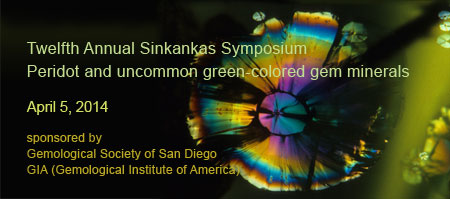 |
Note that the speaker lineup has changed. Visit the Sinkankas Symposium website for speaker bios and abstracts of presentation topics.
 |
| Envious? Andalusite is beautifully pleochroic. This 3.37-carat oval is from Brazil. Inv. #21617. (Photo: Mia Dixon) |
The Sinkankas Symposium is organized by Roger Merk, and co-sponsored by the Gemological Society of San Diego and the GIA (Gemological Institute of America). It will be held Saturday, April 5, 2014, at the GIA World Headquarters and The Robert Mouawad Campus, 5345 Armada Drive, Carlsbad, CA 92008.
The registration form is now posted on the Symposium website. Or register online.
Early-bird registration ends on March 18, 11:59 pm Pacific Time, when it goes from $95.00 to $105.00 per person Registration includes refreshments, boxed lunch and one copy of the printed book. Absolute deadline is April 1. No onsite registration.
Use either the form/s-mail or the online registration to pre-pay for extra copies of the Peridot book and/or the revised edition of the Ruby book and get them for $30.00 each (delivered at the Symposium); at the Symposium, they will be $38.00. [back to top]
Views on TucsonAs she always does, our friend Eloïse Gaillou, curator of the Natural History Museum of Los Angeles, shares her favorite sights from the gem and mineral shows, and last month in Tucson was no exception. Her posts are divided in two—Gem Shows and Mineral Shows—but there is plenty of crossover, with the first image shown below appearing on the latter page. Walk in hungry.
We were just informed by Eloïse that the Gem and Mineral Council of the Natural History Museum is offering a tour of Burma in the fall. Details here. (The European tour we mentioned last month has been cancelled.)
Tucson TimesThe New York Times yesterday ran a follow-up to Tucson. "On the Origins of Gems" looks at some of the trends both at Tucson and in the larger (is there a larger?) market, and issues such as rarity and locality. Amongst those quoted: Robert Weldon (GIA) on Ethiopian white opal, Richard Hughes (Lotus Gemology) on the rainbow hues of Madagascar sapphire and pigeon's blood ruby, designer Erica Courtney on a missed opportunity (Paraiba tourmaline from Brazil, too expensive at $300/ct—twenty years ago). [back to top] |
Pala International NewsPala's Featured Stones: SpinelsSpinels continue to grow in popularity, keeping demand on the rise. As this awareness grows, the bounty of fancy colors opens up to a whole new group of collectors. Spinel requests are branching out from the classic red hues into green, blue-greens, blues, lavenders, pinks and beyond. These fancy colors are completely natural, coming out of the ground in this wonderful array. Although singularly refractive, spinels often display a pleasant mix of hues and exhibit a slightly higher dispersion than sapphire, giving them a more lively character in some cases. There are also color-change and color-shifting spinels, taking on different colors in different lighting. Supplying the demand seems to be the tricky part these days, so Pala International is continuously gobbling up all the spinels we can get our hands on.
Check out our extensive collection of spinels here. Interested? Select inventory numbers above, call (phone numbers below) or email us to inquire. [back to top] |
ImageologyGemologist and author Richard W. Hughes presented in Tucson last month on the topic of "Ruby & Sapphire: A Collector's Guide" (coincidentally the title of his new book). Pala International's Bill Larson was so impressed by the presentation's closing montage, "Lands of Red & Blue," that we asked Hughes to share it with our readers. He complied, providing us with an added treat, "Source."
[back to top] |
Industry NewsÀ la mode: Color on the Carpet
Industry writer Deborah Yonick provides her take, via AGTA, on the recently concluded Academy Awards. Pictured in her report are Jennifer Lawrence sporting a back-draped carved rock crystal and diamond, a green tourmaline and diamond pendant worn by Jennifer Lee, and Catherine Martin wearing a yellow diamond and amethyst arrows brooch-pendant. Martin won an Oscar for costume design for The Great Gatsby, on which she collaborated with Tiffany & Co. in jewelry design. Other celebrities pictured: Amy Adams with rhodochrosite, lapis, turquoise and diamond earrings; Cate Blanchett in opal chandalier drop earrings; Olivia Wilde in jade and diamond earrings; Lupita Nyong'o accessorized with a 19th century yellow gold and diamond coiled snake bracelet, an 18k yellow gold frog ring, a 19th century yellow gold, pearl and diamond ring, a 19th century yellow gold and opal ring, and a 1960s 18k gold, turquoise, and diamond ring; and more… To browse some of the jewels close-up, see the Jewels du Jour blog. [back to top] |
Giving Back in AfricaLast April we noted the efforts of award-winning gemstone faceter Lisa Elser to give back a portion of her profits to the people of the countries that produce her gorgeous stones. In 2013 she and her husband Tom Schlegel donated medical equipment to Dr. Ikem Onwude, who conducts free weekend clinics in Abuja, Nigeria. They hope to finance a medical safari to the country's mining regions in 2014. (Learn more about their give-back initiatives here.) Elser and Schlegel also are involved with the drilling of drinking water wells and building of sanitary latrines, with the aim of one of each per year. The wells free people from the time-consuming drudgery of having to haul water from far-away sources. The couple work in Tanzania with MSABI, a program that describes itself as "a demand-driven, replicable and expandable model for the implementation of cost-efficient community based water, sanitation and hygiene (WASH) projects."
Another project that Elser and her husband work with is the Devon Foundation: "Bringing Gemology & Lapidary Education to Gem Mining Communities." The organization is directed by Nancy Schuring, Debbie Swinney, Joe Portale and Jim Fiebig. As readers of our pages are aware, one of the challenges of gem-producing countries in the global south is creating value-added products in the countries themselves rather than shipping all rough abroad. (The situation was briefly outlined in a National Geographic Onward report last fall.) The Devon Foundation began facilitating this by awarding scholarships in the lapidary arts to students in Madagascar for whom such schooling was beyond their reach.
When the country's political situation changed in 2011, the foundation turned its attention to the already-existing Arusha Gemmological and Jewelry Vocational Training Center in the famous gem-producing locality of Tanzania. (See Robert Weldon's report on his visit on behalf of GIA during the 2012 the Arusha International Gem and Mineral Fair to learn how it could serve the local community with gemological education and resources.) Using Devon Foundation funds, the school is adding a new classroom. Foundation associates also donate textbooks and supplies on visits to the school. For their part, Elser and Schlegel work with another educational endeavor, Southern and East African Mineral Centre, based in Dar-Es-Salaam, which provides training in gemology and gem cutting as well as several other mineral-related courses.
Trade Group Pursues Responsible SourcingThe trade organization Precious Stones Multi-Stakeholder Working Group, formed last April in Paris, met last month during the AGTA GemFair. According to a February 21 press release, PSMSWG is "an open, non-exclusive coalition of companies, associations, NGOs and governments sharing an interest in responsible sourcing and supply-chain due diligence for precious stones." Many in the colored gem trade, however, question the accuracy of this representation. We are told there are issues of transparency and process that trouble some participants. The group is investigating application of due diligence guidelines by entities such as the Organisation for Economic Cooperation and Development (OECD). The group's study on this issue is slated for a late spring release. Some in the trade feel that while the concept of the study is laudible, there are concerns: it is being rushed, it lacks input from some parties, and thus it may be flawed. The group has regular conference calls; contact information is available in the press release. Tune in next month, when we will cover the working group and its efforts in more depth. [back to top] |
Research RoundupA Treated Stone Sold as "Black Sapphire"
In January, GIT Testing Laboratory issued a report on a parcel of gems being marketed as "black sapphire." According to "A Treated Stone Sold as 'Black Sapphire'," this type of material is found from western China to Australia. Microscopic examination with strong fiber optic light revealed dark blue coloration along healed fissures. Under shortwave ultraviolet light, the stones glowed weakly a chalky blue mostly in the healed fracture areas. Refractive index was normal for corundum. Dicroscopic examination revealed very dark to dark blue colors. Advanced analysis also was performed and it was concluded that the stones had been treated by common titanium diffusion, but with a bit of a twist. Titanium is able to penetrate only slightly; the fissures allowed it go deeper. Update on Gemstone Mining in Luc Yen, VietnamSixteen months ago, we pointed to a Gems & Gemology cover that featured a "luscious jumble" of a ruby specimen from Luc Yen, northern Vietnam, in the collection of Pala International's Bill Larson. We also included Will Larson's story about the acquisition of that specimen—through the eyes of a 12-year-old. Also on that cover were three faceted stones, also from northern Vietnam: a blue spinel, a red spinel and a ruby. Beautiful. But Luc Yen produces more than spinel and ruby, as the current edition of Gems & Gemology certifies. "Update on Gemstone Mining in Luc Yen, Vietnam," by Pham Van Long, Vincent Pardieu, and Gaston Giuliani, looks at corundum and spinel, but also tourmaline, feldspar, and pargasite and humite (the latter two often being associated with spinel). The article begins with history and geology, moving on to the mining (include a chart of more than 30 mining sites) and trading. Nicely illustrated, as demonstrated by the image below.
[back to top] |
Burma BitsJade jottings…
Last month we led off pointing to a report in the official New Light of Myanmar daily, that a jade boulder weighing 15 tons had been found in Hpakant, in Kachin State. It had been found on February 9. By February 20 that boulder had increased in size to 50 tons, according to The Irrawaddy. The reason for the discrepancy is that, iceberg-like, most of it was still in the ground. On the 20th, Democratic Voice of Burma (DVB) reported it was "a 37-ton slab" and that the Burmese army had moved in to secure the area. But by the 26th, DVB reported it was "nothing but a rock," according to Kachin State minister of mines, Aung Naing. This was contradicted by locals, but the minister said it would be placed on display to prove his case. Apparently during moving the boulder had cracked proving it was just an ordinary rock. Prior to its identification, Kachin News Group (via AP) quoted a man who said the Kachin Independence Organization had been offered 10% of the boulder's value. The same day as its report on the boulder, The Irrawaddy published a scathing story on jade mining in Hpakant, titled "From Jade Land to a Wasteland." One jade dealer, U Cho, likened the dynamite-blasting method employed to the collapse of the World Trade Center on September 11, 2001. A mountain can be here and gone within the space of a month, he said. Somewhat ironically, in a section of the article titled "The wages of peace," it's pointed out that such extraction didn't begin in earnest until the rebel Kachin Independence Organization signed a ceasefire agreement with the military junta. In other dour news from Kachin, the Myanmar Times describes as a "fiasco" the upgrading of the Hpakant-Moegaung road. (See "Burmese Jade: The Inscrutable Gem" for why this road might need some work.) When Vice President Sai Mauk Kham visited the state last August, locals asked him to facilitate the improvement. This began a bureaucratic nightmare involving mining entrepreneurs, which the article describes in detail, closing with the following:
Jewelers Ticked, Tickled
Meanwhile, Burma's jewelers have made their own demands on the government. Tired of selling only to Burma residents and foreigners who attend the periodic gem emporiums, the jewelers want to open the market, according to a March 10 Myanmar Times story. Their challenge is the same as that faced by Tanzanian crafters (see above): visiting dealers buy rough, which they carry back to the home country, leaving the local value-added producers out of the loop. In welcome news to jewelery dealers, Burma's parliament revised the 2014–15 tax law, halving the commercial tax on finished jade and gemstones, from 30% to 15%, according to a story in yesterday's Myanmar Times. The tax on rough remains at 30%. Somewhat contraditorily, March 11 coverage of tax reform by The Irrawaddy stated, "Burma’s rich natural resources, such as jade, gems and timber, have mostly flowed out of the country unregulated and lightly taxed during past decades of military rule, generating little in the way of government revenues." But a related DVB story stated that country's Internal Revenue Department issued a list of over 10,000 Burma companies that have evaded tax since 2012. Jade SalesIn statistics that appear to match those we noted last month, Eleven Media Group reported yesterday that exports of jade for the first nine months of Burma's 2013–14 fiscal year (Apr–Dec) reached $920 million. This tops the total for the entire 2012–13 fiscal year, of $297 million. Bite-Sized Bits
[back to top] |
BooksExotic Gems, Volume 3 by Renée NewmanHow to Identify, Evaluate, Select and Care for
|
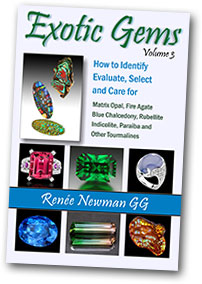 |
It's been three years since our review of Renée Newman's Exotic Gems, Volume 2—not that she's been out of sight. Last year, she published Gold, Platinum, Palladium, Silver & Other Jewelry Metals. And 2012 brought us her Rare Gemstones, which featured several stones from the Pala International inventory that are still available. But enough about past achievements…
Volume 3 of Exotic Gems begins, in Chapter 1, "Exotic Gems," by answering a question the savvy gem enthusiast might raise: What's so exotic about tourmaline? Answer: The Dowager Empress Tzu-Hsi, who may be remembered as having installed China's last Emperor while on her deathbed. To gemstone lovers she's remembered for her passion for pink (also pearls and jade). Tourmaline, Newman informs us, was to the Dowager Empress truly exotic, because there was no local source for the material. It was her ardor for rosy tourmaline that drove a mining boom in San Diego in the years before her death in 1908.
As Newman points out, the exotic isn't only the distant and alien. "Strikingly, excitingly or mysteriously different or unusual" gems, like multicolored and Paraiba tourmaline also fit the bill. Newman goes on to describe briefly the characteristics of each of the gemstones to which she devotes single or multiple chapters. For instance tourmaline, in all its diversification, is discussed across seven chapters.
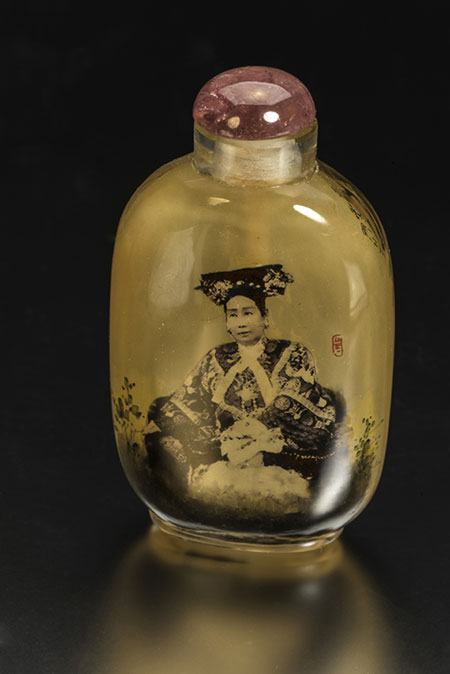 |
| Above, the image of Dowager Empress Tzu-Hsi adorns a bottle with a stopper of pink tourmaline, her favorite gemstone. (Photo: Mia Dixon, Pala International) Below left, watermelon tourmaline pin/pendant by Paula Crevoshay (Photo: Paula Crevoshay Studio) Below right, Paraiba tourmaline from Evan Caplan (Photo: Harold & Erica Van Pelt) |
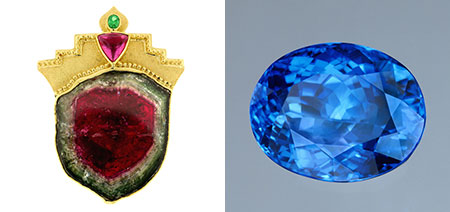 |
Chapter 2 is devoted to pricing vis-à-vis not just the Four C's (color, clarity, cut, carat weight) but also transparency (distinct from clarity); brilliance; treatments; content of copper, chromium and/or vanadium; origin; and phenomena. To illustrate cut, Newman includes the photograph by Wimon Manorotkul of a faceted quartz with a single needle of black tourmaline extending from culet to table like an axis, creating a wild kaleidoscopic effect.
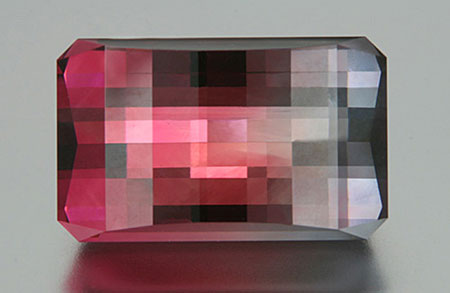 |
| An example of inventive faceting: a bicolor tourmaline cut by J. L. White Fine Gemstones. (Photo: Jeff White) |
Chapter 3 is a general overview of tourmaline, including a brief history, beginning with a tourmaline intaglio, ca. 3rd century B.C.E., depicting Alexander the Great. (It is housed at the Ashmolean Museum, which has an online exhibition of intaglios in other materials. Exotic Gems also features examples of modern intaglios.) Tourmaline identification and chemistry are handled next, followed by the characteristics of the five tourmaline species: elbaite, dravite, uvite, schorl and liddicoatite. The reader then turns to a four-page pictorial of faceting by master cutter John Bradshaw, who also contributes an essay on cutting. The chapter ends with notes on tourmaline care.
Chapter 4 covers Paraiba and other copper-bearing tourmalines, species: elbaite, beginning with a history of the Brazilian locality that gave its name—grudgingly—to material that hails from Brazil to Nigeria to Mozambique. Newman succinctly reviews the name-game issues, including "a lack of consensus" regarding issues of appearance in material from disparate localities. (Also included at the chapter's end are alternate monikers for this material—a slew of them: Caribbean-blue, electric green, neon, Seafoam, sky-blue, swimming-pool blue, turquoise blue, and even Windex-blue, a term often applied to blue topaz.) Newman then looks at identification of this cuprian tourmaline, followed by price factors. We should note here that this chapter (like the others) is abundantly illustrated. A favorite from this chapter is a necklace incorporating both African and Brazilian copper-bearing tourmaline.
Chapter 5 looks at blue to green tourmaline. The blue variety, called indicolite, is explained, followed by green, or chrome, tourmaline. Just to keep you on your toes, another green tourmaline is thrown into the mix: verdelite, or tourmaline that is green, but not due to chromium, copper or vanadium. Blue-green and gray tourmaline are discussed next, with the chapter being rounded out by identification issues.
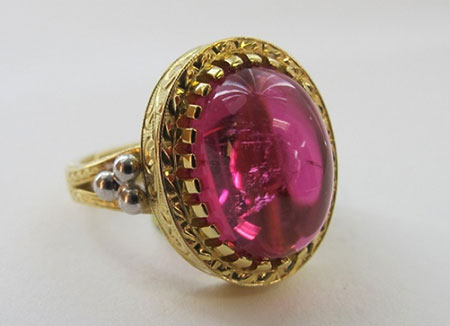 |
| Pink tourmaline ring by Andrew Sarosi. (Photo courtesy Andrew Sarosi) |
Pink and red tourmaline, aka rubellite, are examined in Chapter 6, and if you needed proof that the Empress Dowager was onto something, look no further than the handsome ring pictured above. Evaluation tips and sources are discussed after a general overview.
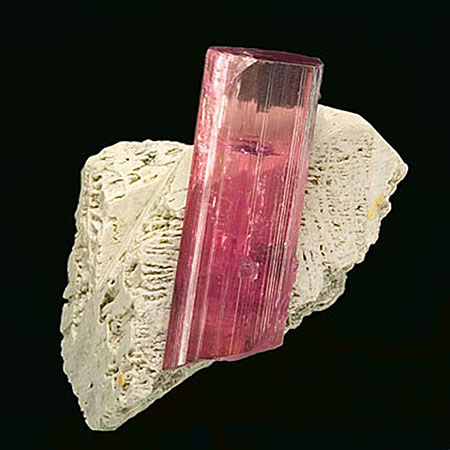 |
| Chapter 6 (along with the others) contains examples of lovely mineral specimens like this tourmaline from the Himalaya Mine in Mesa Grande, California, with etched feldspar. (Photo: John McLean, Pala International) |
Chapter 7 deals with yellow, orange and brown tourmaline. Illustrated are stones in hues of canary yellow, lemon yellow, yellow green, golden and pleochroic orange, and salmon. Yum.
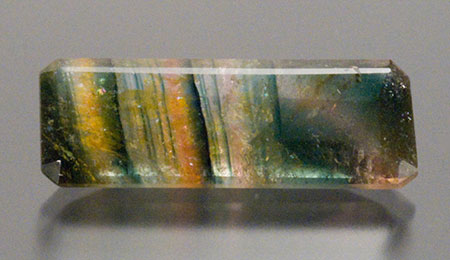 |
| Liddicoatite from Pala International. (Photo: Mia Dixon) |
Multicolored tourmaline is the subject of Chapter 8. The geologic origins are discussed before looking at liddicoatite (a variety with pronounced color zoning), effect of zoning on price, pleochroic multicolor (!) effect, and a gallery of jewelry employing this material. Chapter 9 covers cat's-eye and color-change tourmaline.
Whew! Did you think we forgot the other Exotic Gems? Blue chalcedony is next, in Chapter 10, and we're reminded to compare and contrast the subtleties of this stone with Pantone's color of the year, Radiant Orchid. Let the picture below speak its thousand words. Yum yum. Newman gives this the full treatment: definition, identification, sources near and far, quality and care.
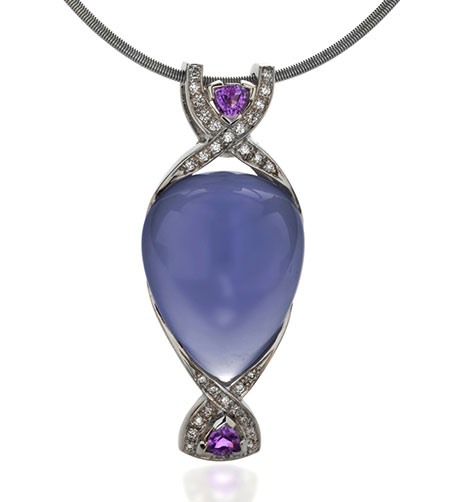 |
| Blue chalcedony pendant by Leslie Weinberg. (Photo: Robert and Orasa Weldon) |
Next up is fire agate in Chapter 11. This might be an acquired taste for some. As Newman writes, "If you're attracted to the color play of opal and the iridescence of ammolite," this material is for you. After an overview, Newman covers price factors, cutting and care. Two pages are devoted, again, to a master cutter's technique, courtesy Ryszard Krukowski.
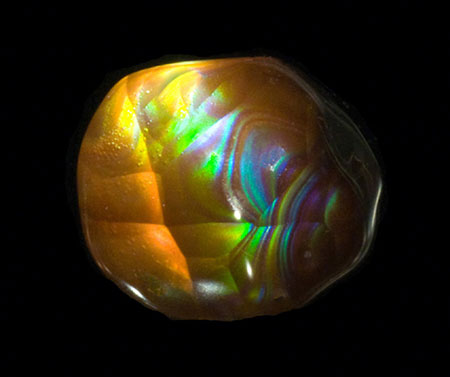 |
| Fire agate from Pala International. (Photo: Mia Dixon) |
We love matrix opal and were delighted by the variety of examples included in the 12th and final chapter of Exotic Gems. Newman covers the five main types: boulder matrix opal, Yowah nut or Koroit nut, Andamooka matrix opal, Mexican (aka fire) opal matrix, and Honduras matrix opal. She then looks at identification traits (beware the synthetics), pricing and evaluation and, finally, care.
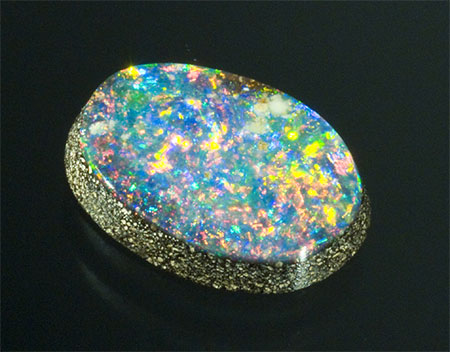 |
| Boulder matrix opal from Pala International. (Photo: Jason Stephenson) |
Exotic Gems includes a three-page bibliography for further reading. You'll want to keep this handy both as a reference but also as a reminder of the variety of Planet Earth's bounty. The book can be purchased at major bookstores and jewelry supply stores, or via the link on the author’s website. [back to top]
Pala Presents
With Pala Presents, we offer selections from the collection of Pala International’s Bill Larson, who will share with us some of the wealth of information in the realm of gems and gemology. And, as with this edition, gemstone-related collectibles. Lucky Bloodstone: Birthstone Collecting CardsBloodstone, a birthstone for March, is the third in our series of collecting cards that we'll supply over the next twelve months. For more information on birthstones, see Palagems.com.
[back to top] — End March Newsletter • Published 3/18/14 — |
|
Shows and Events
Pala International NewsGems and Gemology NewsIndustry NewsPala Presents |
Islamabad Gem Exhibition: Feb. 21–23, 2014The 4th Islamabad Gem Exhibition is scheduled for February 21–23, 2014, but you wouldn't know it from the Pakistan Gems and Jewellery Development website, which makes no mention. Details are available in the poster below.
See also this 13-minute documentary about the gems and jewelry industry of Pakistan, filled with eye candy.
[back to top] |
Bill Larson to Address SDMG 80th Annual Banquet
It's been a year of milestones, with the Tucson Gem and Mineral Show celebrating 60 years, and the San Diego Mineral and Gem Society marking its 80th birthday. Pala International's Bill Larson will be the featured speaker for the latter bash, to be held on Saturday, March 8, 2014, 11:30 a.m., at the 94th Aero Squadron Restaurant, 8885 Balboa Ave., San Diego. Bill will show highlights from various mines in San Diego County—exceptional specimens that include morganite, kunzite, garnet, and rare gem species. He noted, "I was the speaker at the 70th anniversary, so I guess my goal is to speak at the 100th!"
Ticket info and more details for the banquet available here. [back to top] |
Twelfth Annual Sinkankas Symposium – Peridot and Uncommon Green-colored Gem MineralsApril 5, 2014, GIA World Headquarters and
|
 |
Visit the Sinkankas Symposium website for speaker bios and abstracts of presentation topics.
 |
| Envious? Zircon comes to us in a rainbow of hues, often colorless, golden, or ruddy. This natural green variety is more rare. Inv. #20069. (Photo: Mia Dixon) |
The Sinkankas Symposium is organized by Roger Merk, and co-sponsored by the Gemological Society of San Diego and the GIA (Gemological Institute of America). It will be held Saturday, April 5, 2014, at the GIA World Headquarters and The Robert Mouawad Campus, 5345 Armada Drive, Carlsbad, CA 92008.
The registration form is posted on the Symposium website after past attendees are sent their invitations. Join the San Diego Mineral & Gem Society mailing list to be kept informed; after submitting your email address, be sure to select the Sinkankas Symposium checkbox.
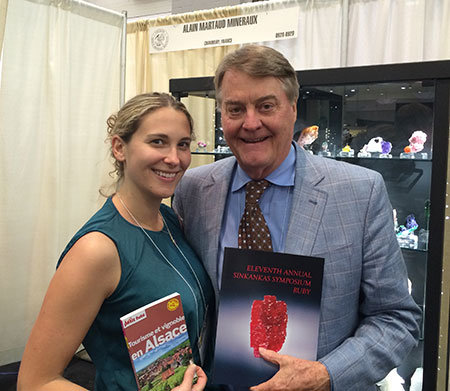 |
| Pala International's Bill Larson poses in Tucson with Eloïse Gaillou, curator of the Natural History Museum of Los Angeles. Eloïse has her Alsace guidebook in preparation for the "European Gem & Mineral Experience: a trip organized by the curatorial staff of NHMLAC," June 27th – July 7th, 2014, with stops in Idar-Oberstein, Sainte-Marie-aux-Mines, mines & vines & wines, and more. (Note: This tour has been cancelled.) Bill holds the revised edition of the proceedings of the Eleventh Annual Sinkankas Symposium – Ruby. This lovely, 130-page volume, co-published by Pala International, will be available for online purchase soon; check the Symposium website for news. The cover star of the proceedings is the Hixon ruby, which happens to be owned by Eloïse's institution. It's a pristine natural crystal, from the Mogok Stone Tract; at 196 carats, it is one of the finest Burmese rubies on display in a public museum. The ruby was photographed by Harold and Erica Van Pelt. (Photo: Will Larson) |
[back to top]
2nd China (Changsha) Mineral & Gem Show:
|
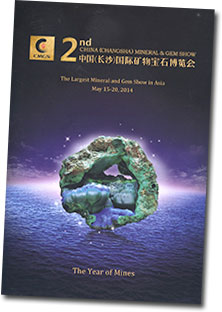 |
| The theme of this year's show is "Mines." |
Take a breather after Tucson, buy a new pair of sensible shoes, and take off for the 2nd China (Changsha) Mineral & Gem Show, May 15–20, 2014. With two floors and hundreds of exhibitors, you'll want to be light on your feet. Trade-only days are May 15 and 16; public days are May 17–20, at the Hunan International Conference & Exhibition Center.
Reports on last year's show by Pala International's Will Larson as well as by Dr. Peter Megaw and Allison Megaw noted room for improvement, mainly in timely delivery of international dealers' shipments through customs. (And the wine list could have been ramped up a notch.)
Last year's show theme was "Mineral Museums," and the Megaws wrote that the Chinese government was working on the development of more than a thousand new natural science museums. Four hundred were opened in 2011 alone, according to a show statement. "Not only have the newly opened museums had great procurement demand in mineral and gem collections," reads the statement, "but also the public." [back to top]
Maya: Hidden Worlds Revealed
|
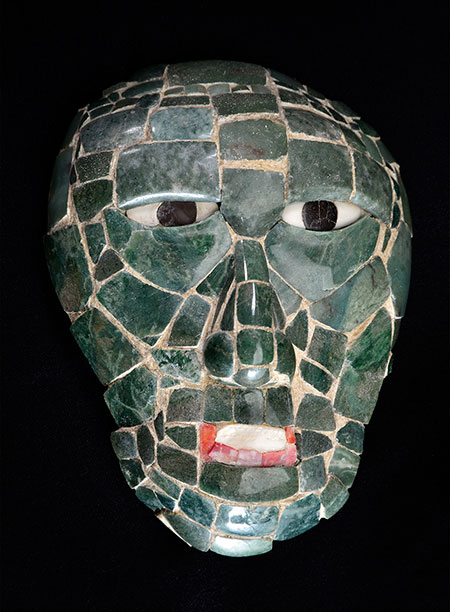 |
| The mask, above, was found in the tomb of Great Scrolled Skull, a ruler of Santa Rita Corozal in Belize during the Early Classic period (250–900 C.E.). A symbol of power, Great Scrolled Skull probably wore it as an ornament on his belt or on a necklace. The mask's jade, shell, and obsidian were attached to an organic backing that had decomposed, so when it was found, it was a pile of chips that had to be reconstructed. For more on Maya jadeite, see this profile of work by George E. Harlow, curator of the American Museum of Natural History. (Image courtesy of the National Institute of Culture and History and Science Museum of Minnesota) Below, mosaic ear flares. Ear flares, also known as spools, have had a resurgence in popularity in recent years. The Maya believed that the ears—like the eyes, mouth and nostrils—were pathways to the mind, soul and other spiritual dimensions. (Photo courtesy National Institute of Culture and History) |
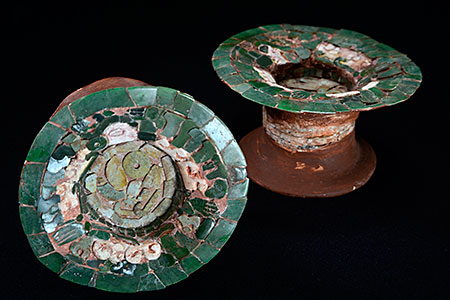 |
The exhibition is the largest concerning the Ancient Maya ever to be displayed in the United States. (Having left Minneapolis, it will travel to Boston's Museum of Science Oct. 10, 2014 thru May 3, 2015, and the San Diego Natural History Museum June 12, 2015 thru January 3, 2016.) On display are more than 250 Mayan artifacts, including jewelry, stonework, astronomical and calendrical devices, burial objects, tools, and more. One hands-on exhibit explains the method of dental modification, i.e., use of a bow drill to allow placement of decorative stones in incisors.
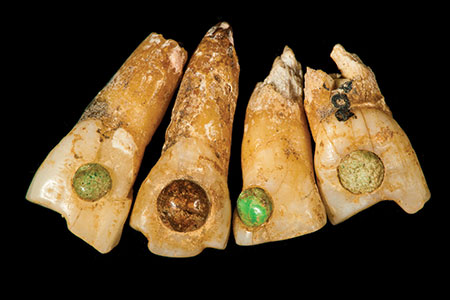 |
| Above, incisors decorated with stones. Note that the teeth also are filed—as well as filled. (Photo courtesy Science Museum of Minnesota) Below, a gold mask ornament. It is hammered and delicately embossed. Made from imported gold, this eye piece once decorated the ceremonial mask of a priest or ruler. Writhing feathered serpents formed "brows" above the eye holes. (Photo © President and Fellows of Harvard College, Peabody Museum of Archaeology and Ethnology, 10-71-20/C7679, 98600128) |
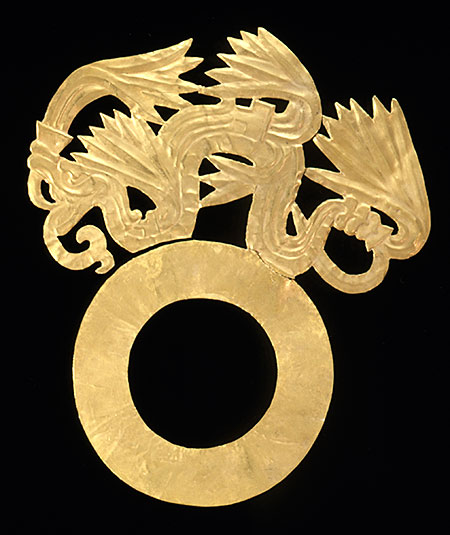 |
The exhibition planning began in 2008, followed by the exhibit team's first stop at the Denver Museum of Nature and Science and a tour of the museum's Maya collection. Also visited were the Peabody Museum of Archeology and Ethnology at Harvard, the National Institute of Culture and History, and the San Diego Museum of Man. In addition to contributions by these institutions were textiles from Maya villages in the Highlands of Chiapas, Mexico, as well as artifacts from the University of Pennsylvania Museum of Archaeology and Anthropology.
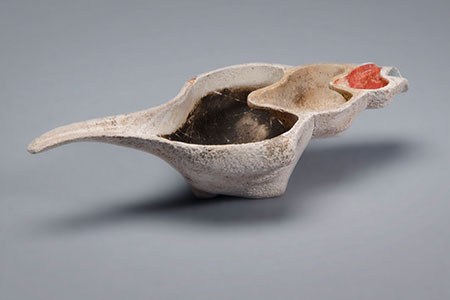 |
| This halved conch shell makes an elegant ink pot for mixing and storing paints. Although often depicted in Maya artwork, few of these have survived. (Image © Science Museum of Minnesota) Currently on display at the Minneapolis Institute of the Arts is Shells: Magic and Science, which includes a beautiful 17th-century goblet (pictured here) fashioned from a Nautilus shell, decorated with a piscine ornament on the coil top and stem in the likeness of Neptune astride a seahorse. Such objects would be found in Renaissance-era Wunderkammern, or cabinets of curiosities. |
Maya is the inaugural exhibition for the Denver museum's Anschutz Gallery, part of the 126,000 square foot, five-level, $56.5 million Morgridge Family Exploration Center. In addition to galleries and classrooms, two underground floors—63,000 square feet—are devoted to the Rocky Mountain Science Collections Center, providing consolidated housing for the first time of nearly 1.5 million artifacts and specimens.
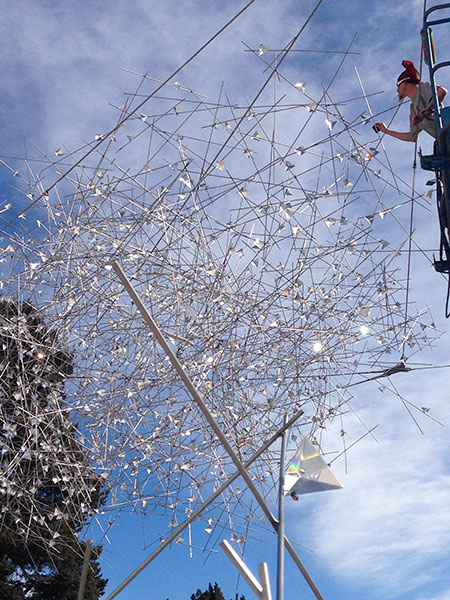 |
| From ancient to modern. Iridescent Cloud, by Laura Haddad and Tom Drugan, graces the new wing's Nature Plaza, which fronts the entrance. The faceted "crystals" are suspended between three stainless steel columns. Above, a worker cleans from a hydraulic crane last Thursday, as a section in the foreground awaits installation. "The artists' concept was inspired by the Museum's gems and minerals collection, exhibits about the physical properties of light, and Colorado's dramatic sun and sky," according to a press release. (Photos: David Hughes, above; Reed Roles, below) |
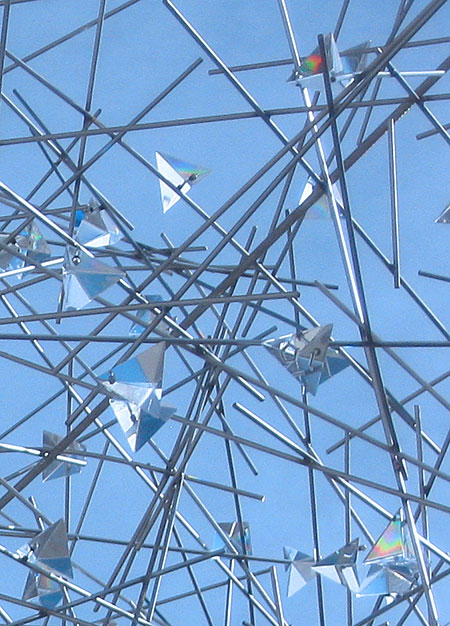 |
Denver also is home to a massive, 3,000-piece collection of pre-Columbian objects, including ornaments made from jadeite, gold, turquoise, shell, obsidian, and more. This collection is housed at the Denver Museum of Art, and you won't have to obtain permission to view it in the basement. Nearly the entire collection is open for permanent viewing on level 4 of the museum's North Building, and made inventively accessible via cruciform display cases that make for efficient use of space.
For even more on pre-Columbian jadeite, Dr. Harlow points us to the following.
And this just in: a Valentine's Day warning from Jezebel.com (billed as "a general-interest women's website) regarding the marketing of Chocolate Diamonds®. Weighing in is Dr. George Harlow. Call it "cognac," call it "champagne," call it "caramel," it still starts with a "B." [back to top]
Black Hats: Tucson in PicturesOn Sunday, Pala people wrapped another Tucson show. We leave you with a few candid shots.
[back to top] |
Pala's Featured Stones: Aquamarine from MadagascarThis month we feature a pair of stunning aquamarines from Madagascar. This gem-riddled island off the coast of southeast Africa is known for producing a wide variety of gem minerals from its extensive network of pegmatites. Beryls grow large in these parts and a new discovery of natural blue aquamarine just hit the market at this year's Tucson show. These aquamarines have strong natural blues hues with flawless interiors. This pair exhibits the quintessential color for aquamarine and each is precision cut into 14-mm round brilliants.
[back to top] |
Pulse PickGem Market Pulse is an occasional freebie offered by the publishers of The GemGuide, the preeminent trade publication for gemstone wholesalers. This month, the Pulse included fluorite as its featured gem, accompanied by a fluorite trio captured by Pala International's in-house photographer Mia Dixon. We thought we'd share it with our readers.
To sign up for the free subscription, visit The GemGuide website and select Subscriber Login > Register. [back to top] |
Beautiful BluesPala International has opened up a new relationship with a supplier overseas who is directly involved with zircon coming out of Cambodia. Our new supplier is one of the biggest buyers of rough material produced by the mines and they are heating and cutting in their facilities as well.
Pala has been buying these beautiful blue zircons for years, but we have hit the mother lode this time. These stones feature stunning electric blue colors in big sizes, matched pairs—just about every shape and size you could imagine in the top color.
Interested? Browse the inventory of blue zircons, call (phone numbers below) or email us to inquire. [back to top] |
Natural and synthetic vanadium-bearing chrysoberylA study by Dr. Karl Schmetzer, Dr. Michael S. Krzemnicki, Thomas Hainschwang and Dr. Heinz-Jürgen BernhardtThe subject of a new study, led by Dr. Karl Schmetzer on natural and synthetic vanadium-bearing chrysoberyl, would fit nicely in the upcoming Sinkankas Symposium, which will look at "peridot and uncommon green-colored gem minerals." The natural material in this study comes from four localities, one of which was examined last summer by Dr. Schmetzer, Dr. Heinz-Jürgen Bernhardt and Christopher Cavey (see "Vanadium- and chromium-bearing chrysoberyl from Mogok, Myanmar" on Palagems.com). Writing in Gems & Gemology's "Lab Notes" column ten years ago (2003, 39[2], 144) about a 4.29-carat bright beauty, Wendi M. Mayerson stated, "It is always a pleasure to see a large natural stone with such vivid color and high clarity." Indeed, mint-green chrysoberyl isn't something you see every day.
The present study was undertaken by Drs. Schmetzer and Bernhardt along with Dr. Michael Krzemnicki and Thomas Hainschwang. It is featured in the current edition of The Journal of Gemmology (2013, 33[7–8], 223–238) under the title, "Natural and synthetic vanadium-bearing chrysoberyl." Readers of the previous article will be interested to compare the Mogok material against that of the three other sources, Sri Lanka, Tunduru (Tanzania) and Ilakaka (Madagascar). This study should provide the data that is lacking on coloration and other properties of vanadium-bearing chrysoberyl, both natural and synthetic. The study begins with an overview of bright green chrysoberyl that entered the market in the mid 1990s—faceted stones so clean that they were suspected to be synthetic. Trace-element analysis detected natural samples that hailed from Tunduru, in southern Tanzania, and which obtained their coloration from vanadium (V) rather than chromium (Cr). Unlike Cr-bearing chrysoberyl (alexandrite), this material displayed no color change between daylight and incandescent light. Had it equal amounts of Cr and V, like some Indian chrysoberyl, a slight color change, from green in daylight to pale grayish green in incandescent light, could have been observed. The discussion then turns to characteristics of synthetic alexandrite as well as synthetic, nearly Cr-free chrysoberyl. The authors note the paucity of published data on V-bearing, non-phenomenal chrysoberyl from sources other than Tunduru. And to the authors' knowledge, only one study containing the polarized spectrum of synthetic V-bearing chrysoberyl—produced by what's known as the Czochralski method—has been published (in 1980 in a Russian journal that is not easily accessible). So there is much room for filling in the holes. The synthetic material consisted of three pieces of rough and 12 faceted samples from the Kyoto Ceramic Corporation, or Kyocera, comparable to the Czochralski method. Twenty-seven natural rough and faceted samples, all with V greater than Cr, were obtained. The samples were examined using standard instrumentation for gemological and microscopic properties (inclusions and growth structures). Inclusions were identified in six of the mostly very clean natural samples by Raman microspectrometry. Chemical data were obtained for all the samples by electron microprobe or X-ray fluorescence analysis. Absorption spectra were recorded, both non-polarized and polarized, and colorimetric data were also obtained for part of the chrysoberyls.
In the synthetic samples, the color was bright green in both incandescent light and daylight; pleochroism was weak in the faceted material, but quite clear in the rough. The dominant color-causing trace element in the synthetic group was vanadium; only tiny traces of chromium and iron were detected occasionally.
The color variation of the natural samples corresponded with the pleochroism that was observed, regardless of origin. Thus all intense and very intense green stones displayed X = yellowish green, Y = green and Z = bluish green, about the same as in the synthetics. Dominant color-causing trace elements are either vanadium (Tunduru and Ilakaka) or a combination of vanadium and chromium (Sri Lanka and Myanmar). The greater the vanadium and chromium concentration, the more intense the green; the yellowish green samples from Sri Lanka had the highest concentration of iron, and in samples from Mogok, the highest vanadium and chromium concentration was detected. UV-Vis spectra show superimposed vanadium and chromium absorptions, as well as minor iron-related absorption bands.
Growth structures and crystal morphology of chrysoberyl and alexandrite already had been documented by Dr. Schmetzer (Journal of Gemmology, 2011, 32[5–8], 129–144; see abstract). Interestingly, growth structures were not observed in the Kyocera material, whereas they have been seen in material grown by the horizontally oriented crystallization method (alexandrites grown by this technique have already been studied by Schmetzer et al. in Journal of Gemmology, (2013, 33[5–6], 113–129; see abstract). Morphology of the rough samples from Tunduru, Ilakaka and Sri Lanka provided a challenge due to their origin from secondary deposits, rendering them waterworn and broken. Using goniometric measurements and observation of internal growth structures, some samples allowed for a complete morphology, which is illustrated in the article via idealized drawings. Just as growth structures were not observed in the Kyocera synthetics in this study, inclusions were almost entirely absent, save for the rare gas bubble. The natural material, on the other hand, contained a variety of inclusions, e.g. apatite, feldspar or calcite, with the exception of the Sri Lanka samples. As the authors point out, the facetable vanadium-bearing chrysoberyl gemstones included in their study should pique the interest of the discriminating collector. Should more of this material become available, especially the attractive Burma bluish green stones (which came to the researchers from collections where they had been housed since the 1970s), gemologists and jewelers will have the information, via the present study, that they need to separate synthetic from natural material, at the very least. The study also demonstrates the value of more rigorous laboratory testing.
[back to top] |
Burma BitsJade jottings…A single jade boulder weighing 15 tons was found Hpakant, Kachin State, on February 9, according to the February 13 edition of the official New Light of Myanmar daily. The football-shaped boulder is 20 feet square. It was found far from the established jade operations, in a vacant plot. It was being guarded by three parties: the local military battalion, police and staff of the Hpakant Township Jade Office.
In other news from Hpakant, Kachin News Group (KNG) reported on January 23 that Burma's military troops in the area "routinely extort money from civilian miners, [according to] jade traders and miners." The story states that "thousands" of miners are working the area, using artisanal methods, whereas mechanized mining has been scaled back or suspended. The post-mechanization state of affairs in Hpakant is the centerpiece of Saturday's editorial by Aung Zaw, founder/editor of the The Irrawaddy, focusing on past and future development in Burma. U.S. assistance to Burma was restricted by legislation signed by President Obama on January 17, as reported the next day by Democratic Voice of Burma. Aid is tied to many issues, including release of political prisoners, fair elections, civil rights barriers still in effect, and prosecution of human rights violators. See also an Irrawaddy interview with Gavin McGillivray, head of the Burma office for the UK Department for International Development, who laments the fact that Burma's extractive industries, including jade, currently are not employing domestic workers, since the material is exported "without being worked." In January, officials from a "people's voice committee" met with leaders of four Kachin political parties to discuss consolidating their efforts ahead of the 2015 national election, according to a January 27 KNG story. Hpakant's jade miners were profiled in a Yangon photo exhibition, as reported by The Irrawaddy on January 20. The exhibition, at Witness Yangon Documentary Arts Space, has closed, but the article does include one wide-angle image of a man hand-picking through rubble at the edge of a mine dump in Hpakant. Gem entrepreneurs meetThe Myanmar Gems and Jewelry Entrepreneurs Association (MGJEA) met a week ago, as reported by Myanma Freedom Daily (MFD) on February 11. At the meeting, the association's chair, Tay Za, complained about U.S. sanctions that still are in place. Burma cannot trade rubies in Belgium, Tay Za said. Chinese trade is open, of course, but he noted that when currency is exchanged, the chain is euro to U.S. dollar to Chinese yuan, a losing proposition. On the 10th, MFD reported that MGJEA officials would complain to the chief minister of Kachin State about a 1% levy assessed on sales, with the proceeds going towards construction of a road between Hpakant and Moe Kaung. Jade salesIn the February 11 MFD article, trade statistics were mentioned. Jade exports for the current fiscal year, which ends March 31, already have surpassed those of the 2012–13 fiscal year. So far, 95,000 tons, worth $980 million, have been traded, compared with 97,000 tons, worth $310 million, last year. (Yes, there may be a typo in these stats, which come via the Ministry of Commerce.) Eleven Media Group reported on Saturday that Burma is $3.7 billion from its FY 2013–14 trade volume goal of $25 billion.
Bite-Sized Bits
[back to top] |
|
With Pala Presents, we offer selections from the collection of Pala International’s Bill Larson, who will share with us some of the wealth of information in the realm of gems and gemology. And, as with this edition, gemstone-related collectibles. The Joys of Love: Birthstone Collecting CardsAmethyst, the birthstone for February, is the second in our series of collecting cards that we'll supply over the next twelve months. For more information on birthstones, see Palagems.com.
[back to top] — End February Newsletter • Published 2/17/14 — |
 |
| Be Mine, Valentine. This andradite garnet from Mexico sports a strong harlequin iridescence. Inv. #14401, 25.89 ct. (Photo: Mia Dixon) |
Garnet is January's birthstone, so we celebrate this stone in style, beginning with our featured stones: spessartite, a mouth-watering variety of garnet. This month's Pala Presents features collecting cards for the month of doorways and beginnings as we look, like Janus, ahead and behind. For the benefit of future generations, and in the spirit of charity (imprinted on one of the collecting cards), Pala International's Bill Larson has gifted fourteen gems and minerals to the Mineralogical and Geological Museum at Harvard University. As noted in the museum's winter newsletter, the donation includes "a red spinel from Burma, four cut gem-quality amazonite gemstones, johachidolite gems in green, pink and gold, cut andradite garnets and a lovely pink tourmaline from California." And looking over our shoulder, we are happy to review a detailed study of ancient garnet: "Greek, Etruscan and Roman garnets in the antiquities collection of the J. Paul Getty Museum" by Lisbet Thoresen and Dr. Karl Schmetzer.
"No gems save garnets should be worn by those who in this month are born."
 |
After the holidays, we're looking forward to the world's greatest gem and mineral show in February. One-stop general information about individual shows can be obtained from the Tucson EZ-Guide.
Pala International will be represented in Tucson as follows. We look forward to seeing our many friends there. Visit the Pala International Show Schedule for future events.
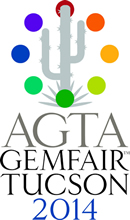 |
Pala joins nearly 100 exhibitors for this trade-only annual extravaganza.
Event: AGTA GemFair
When: February 4–9, 2014
Where: Tucson Convention Center
Pala International Booth: 1016
The event website now features an interactive floorplan allowing you to see who is exhibiting by area of the convention center.
Free seminars by notables in the world of gemstones and pearls are now listed. Special exhibits this year include
Pala International and two dozen other world-class mineral dealers shack up at a Sonoran Desert resort.
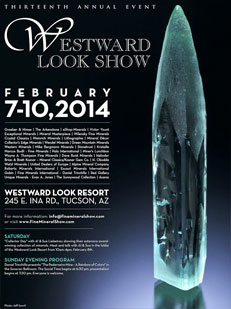 |
Event: 13th Annual Westward Look Mineral Show
When: February 7–10, 2014
Where: Westward Look Resort
Pala International Suite: 224, Building 20, Upper Level
See Pala International's page on the Westward Look Show site. See also this dealer map.
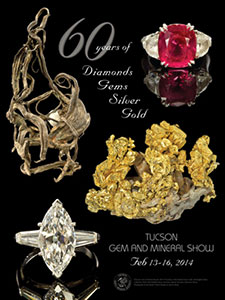 |
TGMS is the largest gem and mineral show in the country. This year's theme is "60 Years of Diamonds, Gems, Silver and Gold."
Event: 60th Annual Tucson Gem and Mineral Show
When: February 13–16, 2014
Where: Tucson Convention Center
Pala International Booth: Aisle 5 East
Take your Valentine to the ends of the earth this year in Tucson.
Bill Larson will discuss "The Gem and Crystal treasures of the mythical Valley of Mogok" on Friday, February 14 in the Crystal Ballroom, 11 a.m. to 12 noon. This talk highlights his 20+ years of traveling to the amazing country of Burma. You won't want to miss it. [back to top]
Many shows will offer their own shuttles. View your transit and parking options here. [back to top]
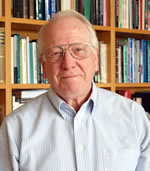 |
Last month the Accredited Gemologists Association (AGA) announced that prominent physicist Dr. John L. Emmett is to be the recipient of the 2014 Antonio C. Bonanno Award for Excellence in Gemology. He is considered the world's foremost expert in corundum enhancements. His various reports on the subject, which appear on (or are cited on) the Palagems.com website, are a valuable asset. John is friends with various Pala International staff members and it's always a treat to see him at the gem shows. We heartily congratulate him on this honor. Below, AGA's press release regarding the award and its recipient.
AGA is pleased to announce that renowned physicist Dr. John Emmett is the recipient of the 2014 Antonio C. Bonanno Award for Excellence in Gemology.
The Bonanno Award recognizes those who have made significant contributions to the gemological field.
Dr. Emmett obtained his Ph.D. in physics from Stanford University. From 1975–1988, Dr. Emmett was Associate Director for Lasers at Lawrence Livermore National Laboratory in Livermore, CA. John is considered a world authority on the physics and chemistry of corundum.
Dr. Emmett's contributions to gemological research are numerous. In the 1990s, John became involved with heat treatment of ruby and sapphire and today is the world's foremost corundum enhancement expert. But it is his work in educating traditional gemologists where he has really excelled. For nearly two decades he has cooperated with the former AGTA GTC and the GIA, along with a host of other gemological organizations and individual gemologists.
John was instrumental in unmasking the beryllium diffusion of corundum through a series of experiments that he designed and conducted. He has worked tirelessly since then to train gemologists in modern scientific methods and encourage gemology to move beyond theory to experimentation in the quest to understand the identification and treatment issues facing this industry. This work has been largely self-funded, donating his time and home lab. Because of his work, with its emphasis on experimentation as a fundamental part of the gemological process, gemologists now have a better understanding of the causes of color not just in corundum, but in gemstones across the board. This idea of experimentation as a means to understanding has revolutionized the science of gemology.
John has repeatedly stressed that knowledge is the common property of all humanity and has willingly shared his expertise with that principle in mind.
The Antonio C. Bonanno Award for Excellence in Gemology will be presented at AGA's Gala Dinner Dance at the conclusion of its Tucson Conference, Wednesday, February 5, 2014, from 6:30 – 11:00 PM, at the Marriott University Park Hotel.
For a vintage example of Dr. Emmett's work, see "Heat Treating the Sapphires of Rock Creek, Montana," co-authored by Troy R. Douhit, Gems & Gemology, Vol. 29 (1993), No. 4, pp. 250–272, available at GIA. [back to top]
Visitors to the Natural History Museum of Los Angeles (NHM) have the chance to view a rare lepidopteran: The Aurora Butterfly of Peace. Curator Alan Bronstein spent twelve years collecting its colorful components—240 natural fancy-colored diamonds arranged in the figure of a butterfly, with a combined weight of 166.94 carats. The exhibition is available for viewing through June 3, 2014, so there’s plenty of time to flit by.
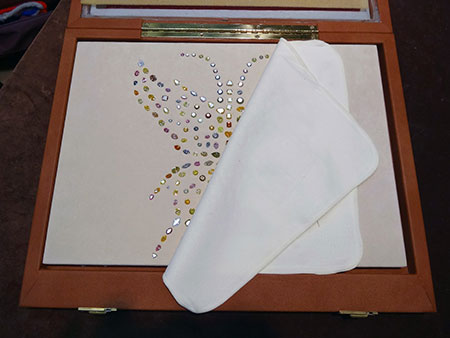 |
| Playing hard-to-get. NHM's Eloïse Gaillou uncovers The Aurora Butterfly of Peace prior to examining some of the stones individually. (Photo © Eloïse Gaillou) |
[back to top]
The annual Sinkankas Symposium has been described by John Koivula as the "best gem mineral symposium in North America" and has a reputation for achieving sold-out enrollment.
This year's theme focuses on green-colored gems that have lower public recognition than their more illustrious counterparts such as emerald, jade, etc., with peridot perhaps the most well-known. For instance, Pala International’s Bill Larson will offer "Green with Envy," a photographic odyssey of fine crystals and cut gems from worldwide localities featuring peridot and a panoply of uncommon green gems of beguiling beauty ranging from A (actinolite) to Z (zircon). Lisbet Thoresen, whose study of ancient garnet we review below, will discuss the disappearing act of the "poor man's emerald" in her presentation, "Chromian Chalcedony: A Gem from History's Lost and Found."
 |
Visit the Sinkankas Symposium website for speaker bios and abstracts of presentation topics.
 |
| Envious? Pakistan produces fine peridot in larger sizes, like this 10.35-carat beauty. Inv. #13165. (Photo: Wimon Manorotkul) |
The Sinkankas Symposium is organized by Roger Merk, and co-sponsored by the Gemological Society of San Diego and the GIA (Gemological Institute of America). It will be held Saturday, April 5, 2014, at the GIA World Headquarters and The Robert Mouawad Campus, 5345 Armada Drive, Carlsbad, CA 92008.
The registration form is posted on the Symposium website after past attendees are sent their invitations. Join the San Diego Mineral & Gem Society mailing list to be kept informed; after submitting your email address, be sure to select the Sinkankas Symposium checkbox.
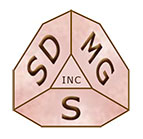 |
It's a year of milestones, with the Tucson Gem and Mineral Show celebrating 60 years, and the San Diego Mineral and Gem Society marking its 80th birthday. Pala International's Bill Larson will be the featured speaker for the latter bash, to be held on Saturday, March 8, 2014, 11:30 a.m., at the 94th Aero Squadron Restaurant, 8885 Balboa Ave., San Diego.
Bill will show highlights from various mines in San Diego County—exceptional specimens that include morganite, kunzite, garnet, and rare gem species. He noted, "I was the speaker at the 70th anniversary, so I guess my goal is to speak at the 100th!"
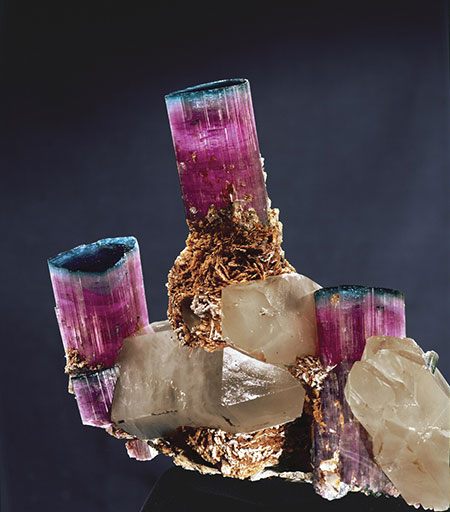 |
| The "Candelabra" Tourmaline was mined in 1972 by Bill Larson at the Tourmaline Queen mine in San Diego County's Pala District. "What a sight," he recalled years later, "over a foot long." (It actually is about a foot and a half.) It now is on public display at the Smithsonian Institution in Washington, DC. (Photo: Harold & Erica Van Pelt) |
Ticket info and more details for the banquet available here. [back to top]
Spessartite draws it derivation from the type locality for the mineral, Spessart, in Bavaria, Germany. Simply put, this is an orange variety of garnet, but the terminology, deposits, and actual colors are far more complex.
Spessartite is more of a mineralogical term for a specific chemical formula (Mn2+3Al2(SiO4)3) within the garnet group. The term spessartine is more often used in Europe but is synonymous with spessartite. Mandarin is a term inspired by the Namibian deposit producing more pure-orange hues.
When the Namibian deposit came online around 1991, the color palette for fine spessartite changed. The material coming out of Marienfluss, Kunene Region was an electric mandarin-orange hue, with some minor pink or red secondary that made it seem very pure and intense. The only drawback to this material was that it often had fine needles creating a silky appearance.
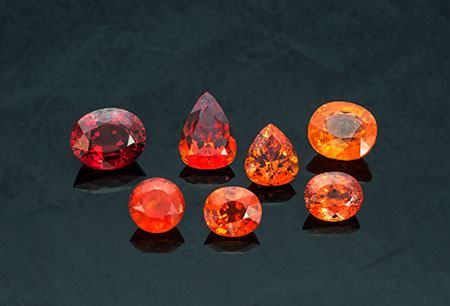 |
| Spessartite Suite: (l–r from top row) 24.80-carat oval from Nigeria (Inv. #13832), 17.71-carat pear shape from Nigeria (#20423), 12.90-carat pear shape from Nigeria (#16043), 22.73-carat cushion from Tanzania (#21599), 12.71-carat round from Namibia (#1531), 10.46-carat oval from Tanzania (#21598), and 11.10-carat oval from Nigeria (#21569). Click to enlarge. (Photo: Mia Dixon) |
The Nigerian deposit was by far the the biggest as far as carats produced. This deposit in Iseyin, Oyo State, Nigeria produced material from dark reddish-orange, to cinnamon orange, to yellowish orange, to mandarin hues. This material is very clean compared to many other spessartite deposits and still holds strong orange colors. Pala International last bought into a large parcel in 2004 and we are still selling off some of this impressive material. And Pala purchases spessartites whenever we can find fine gems.
The most recent spessartite deposit discovery was the massive find in Loliondo, Tanzania, around 2009. At first it seem only to produce fine crystal specimens, but some cleaner faceted gems worked their way into the market. Colors range from reddish orange, to yellowish orange, to mandarin hues.
Although these are the most prolific spessartite deposits lately, there are several smaller but important localities in San Diego County, USA; Burma; China; Madagascar; Pakistan; and Afghanistan.
Interested? Select inventory numbers above, call (phone numbers below) or email us to inquire. [back to top]
Last spring, John S. White delivered a presentation to the 40th Rochester Mineralogical Symposium (RMS) under the title, "Reminiscences of a very old Former Curator." Yes, it was going to be that kind of a talk—filled with the recollections that might be inapt for, shall we say, less pliant, occasions. That's not to say that this talk didn't reflect the earnest passion with which White approached his career. But with this presentation, what might never have seen the light of screen was retrieved from the digital dustbin to provide a different slant on a curriculum vitae that includes, among a host of highlights, time working at the Smithsonian with his mentor Paul E. Desautels, "the most influential American curator of the 20th century" by The Mineralogical Record, itself an influential journal that White founded in 1970.
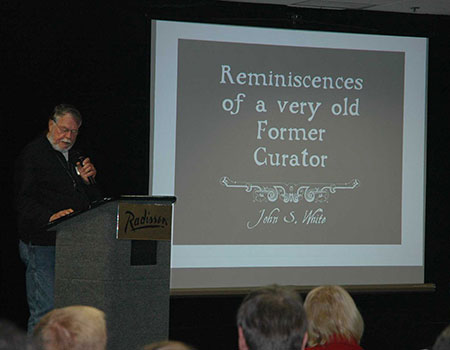 |
| John S. White, speaking at the 40th Rochester Mineralogical Symposium in 2013. (Photo: Elise Skalwold) |
In his RMS presentation, now posted with permission on YouTube, White takes us through his early life, beginning with a fortunate and providential meeting with Desautels. White would be hired by the Smithsonian years later, and in his talk he tours us on the inner workings of the Mineral Sciences Department, displaying a list of the institution's individual collections, as of the mid 1980s, including that of Nobel-winner Carl Bosch: 25,000+ minerals, 3,000 gems and 600 meteorites. On to a five-week European trip in 1967 with world-class dealer Martin Ehrmann. We're taken into the Smithsonian's (non-public) Blue Room and the main hall prior to its renovation.
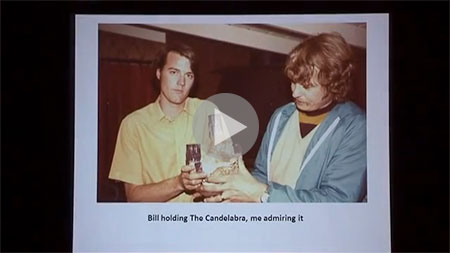 |
| Final payoff. John S. White, right, with Pala International's Bill Larson just after the discovery of the famous blue-cap tourmalines. In his talk, John tells that during this visit Bill gave him a six-inch blue-cap crystal on a time-payment plan. Years later, after John sold his collection, the crystal "disappeared," only to be sold a few years ago for nearly three hundred times the original price of $500. When Bill viewed John's talk, he recalled the crystal passing through the hands of David Eidahl and Louis Schwartz, then "in the late 1980s back to me at $5000. Then, yes, it was sold for $140,000 through Pala International—25 years later." (Image from John White's presentation, posted on the PalaInternational Channel at YouTube by permission of John White and the Rochester Mineralogical Symposium) |
As White takes us through his career (in retirement he remains active as a writer, field collector, and consultant) there are several surprises (defying the curse of the Hope Diamond…), as well as a lot of lovely gemstones and mineral specimens. See for yourself here. [back to top]
In the fall of 2006, your editor was introduced to Lisbet Thoresen, who told me briefly about the work she had been doing on the origin of carved gemstones in the collection of the J. Paul Getty Museum, Villa Collection. Years later, she alerted me to Dr. Karl Schmetzer's (and fellow contributors') important study, Russian Alexandrites, which Alan Hart called "one of the best 'single species' volumes ever published" (Journal of Gemmology, 2010, vol. 32, No. 1–4). In her own review of the book in our pages, Thoresen called it "a painstakingly researched story replete with intrigue, tragedy and epochal sweep worthy of translation to motion pictures."
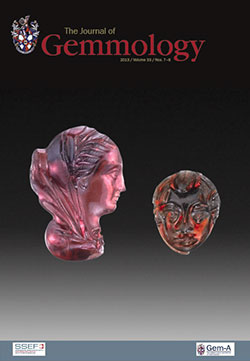 |
| On the cover. A pair of ancient cameo carvings. The Hellenistic pyrope-almandine carving on the left (19.1×12.9 mm) is a royal portrait of a Ptolemaic Queen. On the right is a pyrope cameo of the head of Eros encircled by a plaque (11.7×9.5 mm), a popular motif in Roman glyptic of the 1st century BCE/CE. Inv. nos. 81.AN.76.59 (left) and 83.AN.437.42 (right, gift of Damon Mezzacappa and Jonathan H. Kagan), J. Paul Getty Museum, Villa Collection, Malibu, California. (Photo: Harold and Erica Van Pelt) |
In the forthcoming edition of The Journal of Gemmology (2013, Vol. 33, No. 7–8), Thoresen and Dr. Schmetzer collaborated on a garnet provenance study entitled "Greek, Etruscan and Roman garnets in the antiquities collection of the J. Paul Getty Museum." This study, which began in 1996, compares gemological and chemical properties of 11 garnets with data published on 26 Greek and Roman garnets in five other studies. The objective was not only to characterize the chemical and gemological properties of the gem material but also to identify their possible geographic origins and relationship to ancient trading networks, and even perhaps discern "associations between finished objects now dispersed in different collections," as noted in the study's abstract. (This latter objective, which ventures beyond the bounds of traditional gemological inquiry, Thoresen tells us, is the subject of a second paper in the works.)
The authors begin with a brief overview of garnets used in ancient craft industries beginning with Egypt (4th–2nd millennium BCE) and in Western and Southwestern Asia (2nd–1st millennium BCE). Their use proliferated in the Hellenistic (323–30 BCE) and Roman eras (ca. mid-1st century BCE – ca. 5th century CE), and garnets later reappeared in Medieval cloisonné. Our lexicon is enhanced along the way with antiquarian terms like glyptic ("the art of gem carving") and comparanda ("gems and settings that are stylistically or typologically similar").
Unlike other gem materials, garnets, while common, have a chemical complexity that can sometimes point to a particular source. This chemical signature, however, has not often been investigated in garnets of the Classical world, hence the present study, which includes a survey of previous laboratory techniques before turning to its own analysis in depth.
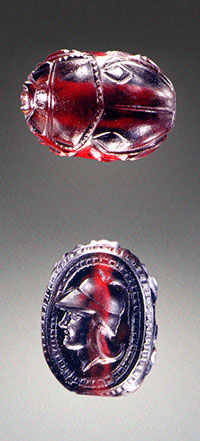 |
| This pyrope scarab (13.3 × 9.4 mm), gem no. 1, is the earliest dated and only Etruscan garnet in the present study (late 4th–3rd century BCE). The flat side is engraved with a helmeted head in profile. While the scarab shape is characteristic of Etruscan glyptic, the use of garnet as a carving material is rare. Inv. no. 81.AN.76.142, J. Paul Getty Museum, Villa Collection. (Photo: Ellen Rosenbery) |
Three graphs plot the chemical composition of garnets from data obtained using electron microprobe analysis performed by Paul Carpenter at Caltech, Pasadena, under the supervision of Dr. George Rossman, and they clearly show the 11 Getty garnets falling into four distinct groups. A fourth plot of refractive index versus density also corroborates their "groupings." Each of the 11 garnets was cast into its percentage end-member components and was shown to belong to the pyralspite solid solution series, with some stones containing a significant grossular component. Gemological properties are also presented as well as optical spectra and 13 photomicrographs of inclusions. The article leads off with a table providing an artistic/cultural description of each of the Getty Museum garnets in the study and a tabular description of the 26 garnets previously analyzed (in five studies) also is included. Plots of the chemical compositions of all 37 ancient garnets then are displayed together. The plots show the positions of two specimens from the earlier studies transposed between groups. "This underscores the importance of gemmological properties," the authors write, "and not only chemical composition for assigning [garnets to a specific] type/cluster/group."
Some of the data on ancient garnets from these six studies showed compositions that could be associated with period-specific use, with garnets of the early Middle Ages tending to segregate away from the earlier dated Classical-era garnets. The reference standards for garnets from known localities appear to provide meaningful data points regarding the shifting political geography and cultural setting for the production of gem arts over time. Perhaps also, the data on the ancient garnets compared against the reference standards from known localities ranging from Northwestern Africa and the Iberian peninsula to Central Europe and further east to South Asia (e.g., India), can shed light on the ambiguities in ancient texts on the subject of gem sources.
As the authors point out, a survey of 37 garnets cannot be definitive regarding sources. More data are needed and need to be examined in relation to ancient texts and archaeological evidence. The authors write, "A preliminary comparison of such data suggests that some deposits used in antiquity were different from deposits used later." Given the scholarship of this paper and what it suggests for future research, we look forward to what lies ahead.
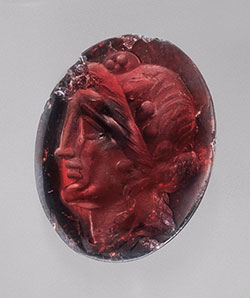 |
| Gem no. 8 is a Ptolemaic oval intaglio (16.0 x 13.0 mm) engraved with the head of Dionysos wearing an ivy wreath (late 2nd–1st century BCE). Inv. no. 85.AN.444.22 (gift of Jonathan H. Kagan), J. Paul Getty Museum, Villa Collection. (Photo: Harold and Erica Van Pelt) |
The forthcoming edition (2013, Vol. 33, No. 7–8) of The Journal of Gemmology will be published on January 20. We're told by recently appointed Editor-in-Chief, Brendan Laurs, that a new relationship between Gem-A and Swiss Gemmological Institute SSEF will result in a new look and broader content for the journal, beginning with the first edition of Vol. 34. SSEF is providing financial support of the journal to make its expansion possible (without influencing its content). More information about the journal is available here. [back to top]
The Canadian Press likened the loss to that of the Hope Diamond. Rocks & Gems Canada, a business in Vancouver's historic Gastown district (named after the area's first saloon owner "Gassy" Jack Deighton), had its front window smashed early December 20 and a thief stole a large ammolite specimen, Alberta's official provincial gemstone. Not only is ammolite revered, but it is protected; the Canadian government must approve its removal from the country.
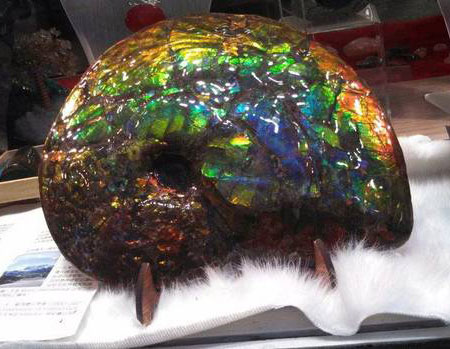 |
| On the lam. Worth about a half a million dollars, this ammolite, stolen on December 20, is considered a national treasure. It is the same material used in jewelry currently on display at GIA, as we reported last month. (Handout photo released on Dec. 23, 2013) |
The shoe-sized specimen measures almost 11 inches. Visible during the day, the window was masked at night, and although protected by bars, the specimen apparently squeezed through. The specimen was from southern Alberta and will be easy to spot at Tucson…
Oh, and by the way, according to Toronto's Globe and Mail, the Smithsonian Institution owns the Hope Diamond and it is not for sale, in case you had some extra Christmas cash. [back to top]
Since 1987, John Hatleberg has created exact replicas and molds (or both) of the world's most famous diamonds, including the Hope and the Koh-i-Noor, for the jewels' owners or guardians, exclusively. Motives behind a replica might vary, but reproductions and even models can be of great significance.
Such was the case with the Koh-i-Noor, once considered the largest diamond in the world. Upon reading about the stone in Ian Balfour's Famous Diamonds (originally published in 1987; now in its fifth edition), Hatleberg was intrigued to see mention of a model of the Koh-i-Noor, made in the spring of 1851 before its recutting, the model having been commissioned by the directors of the British Museum. (Imagine a master sculptor learning by chance of, say, a replica of the Venus de Milo, tucked away in a Greek archive, complete with arms and plinth.) Hatleberg was impelled to meet with Peter Tandy, earth sciences curator of the Natural History Museum, London, in 1992 to see if the model still existed. What they found was precious—in both senses of the word: a glass-covered box inscribed "Do Not Touch." It contained a plaster cast of the Koh-i-Noor, and yes, before it was recut. Consequently, Hatleberg was authorized to make new casts of the original, fragile cast (and its two pendant diamonds) to preserve what might have perished had the box's admonition been ignored. It would be thirteen years of research and requests for permission before Hatleberg was allowed to do what he does best: to fashion a replica of the Koh-i-Noor for the museum's Diamonds exhibition in 2005, a process that took six months. (The full story and its implications are told on JohnHatleberg.com.)
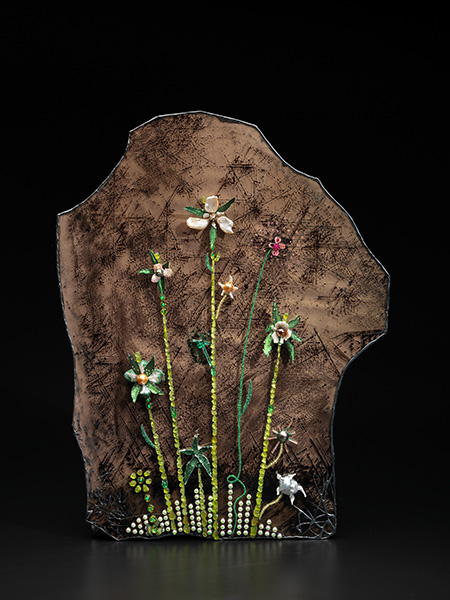 |
| Flower Painting by John Hatleberg, 20 x 15 1/2". Akoya, South Sea, Tahitian, Chinese freshwater, keshi, seed pearls, moldavite, peridot, tsavorite, sphene, fuchsite, lemon quartz, tourmaline, white, yellow, brown diamonds with mica canvas in a patinated silver frame. Click to enlarge. (Photo: John Bigelow Taylor) |
On January 3 of this year, Public Radio International (PRI) profiled John Hatleberg, beginning with an image (ahem; the image does accompany the audio) that may be familiar to our readers: the Hope Diamond glowing like the eye of Luis Jimenez's famous Mustang at DIA. The PRI segment is a personal portrait (as personal as you can get in the space of about 6 minutes), taking you from his studio to his secret vault, and leaving you lusting for more. Well, more might come by way of the fact that Hatleberg is a fine visual artist as well as an exquisite craftsman. His work is quite varied, from a meteorite mirror to a model adorned with 30,000 gems to the whimsicality of a Hope Diamond chocolate and the crazy-quilt expressionism of his own Green Lantern ring.
Hatleberg was kind enough to grace us with three images of these other creations, one of which we'll feature in the February–March edition of our sibling e-publication, Pala Mineralis. We're sure you'll still be left lusting for more…
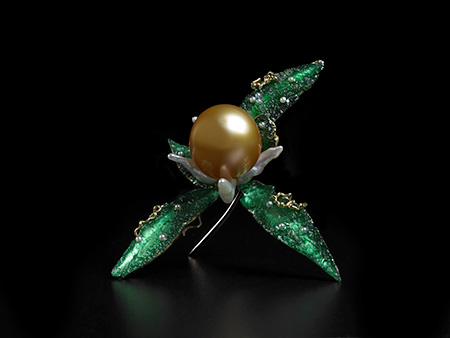 |
| Pin by John Hatleberg. Moldavite and Tahitian, keshi and seed pearls with 18 kt yellow gold. This pin was the inspiration for the flower painting on mica, above. Click to enlarge—please. (Photo: Tony Pettinato) |
[back to top]
Friend of Pala International, George Shen, has had a forty-year career in the jewelry and gem industry. He last appeared in our pages in conjunction with the ICA Congress, held in Changsha, Hunan, China.
Today he sent us images from a December 2013 trip to Mogok, Burma. We share some of the highlights with you below.
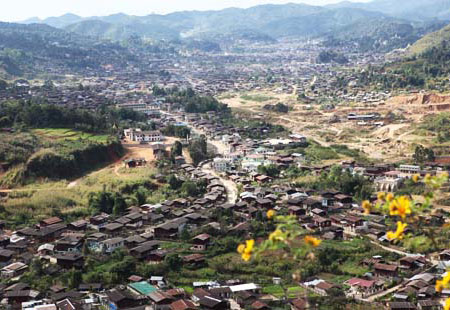 |
| The Mogok Valley is home to half a million people. (Photo courtesy George Shen) |
 |
| A mine in Mogok, with outbuildings perched up top. (Photo courtesy George Shen) |
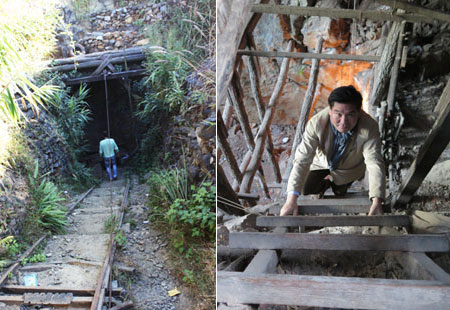 |
| Taking a trip 400 meters into a ruby mine. (Photo courtesy George Shen) |
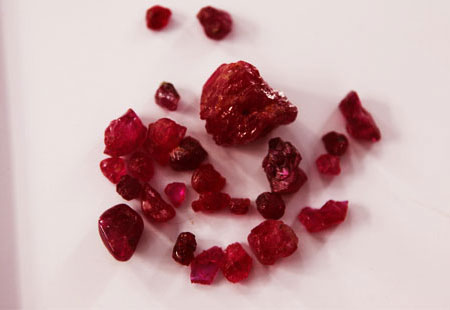 |
| Ruby rough from the mines. (Photo courtesy George Shen) |
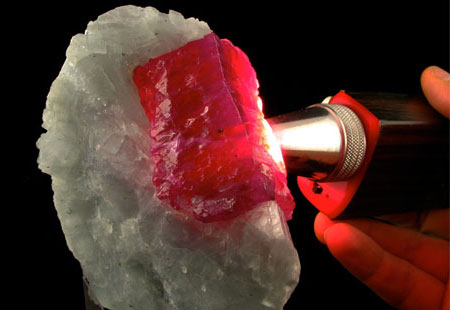 |
| Lovely 1700-carat ruby specimen from the collection of Federico. (Photo courtesy George Shen) |
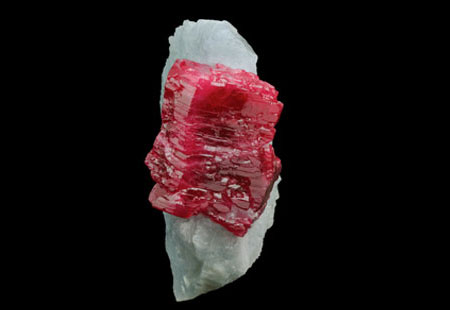 |
| Another ruby specimen from the collection of Federico. (Photo courtesy George Shen) |
[back to top]
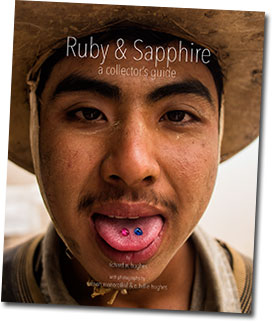 |
In the market for a monograph that is technical enough for the advanced reader but accessible enough for the novice? Such a volume is Richard W. Hughes's new Ruby & Sapphire: A Collector's Guide, which will be hitting the shelves of AGTA GemFair early next month. As brother of the author, your editor had the opportunity to read (and proof) a near-final draft of the book last fall.
As expressed by the title, this book is aimed at the connoisseur, the person building a collection. And because all collections must begin at naught, Hughes points to localities like Australia that might offer the beginner a bargain. But price can deceive and so, via this book, the buyer is armed with a forensics in gemology that balances science against aesthetics (after having received some history and lore, as well as the rules of the road). This is the most technical information, but it is presented cleanly, with lots of space (as is the book's entire layout); inviting, not daunting.
Closest to Hughes's heart is Thailand, where he makes his home, and he devotes a 26-page chapter to the country whose ruby and sapphire production has gone from boom to bust during his 30some-year career, while the country remains at the epicenter of the colored gemstone trade.
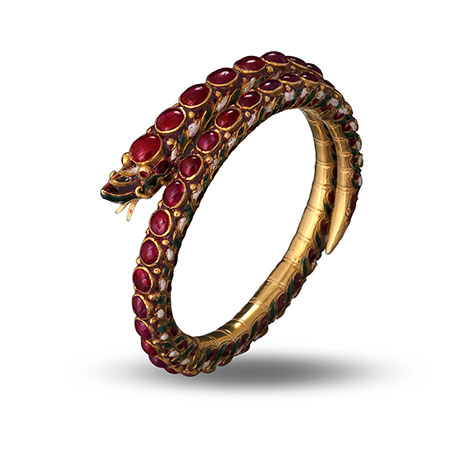 |
| Naga bangle with rubies. Nagas are serpent deities that appear in Thai folklore and Buddhist imagery. Manus Siripatvanich/House of Goldsmiths Collection. Thailand, circa early 1900s. (Photo: Wimon Manorotkul) |
As I noted to my brother while reading the book, one of its nice aspects is that it includes some of the more obscure localities of Africa. When one thinks of Rwanda initially, the Tutsi genocide may come to mind, but this tiny country's tea plantations are home to sapphire deposits that mostly are hand-worked. Mention Kenya, and tsavorite comes to mind, but Kenyan localities also produce the rare facetable ruby, along with many more cabochon-grade stones. I may be stretching things a bit, but as I was wandering the world through Ruby & Sapphire's pages, I was reminded of theatre and film director Peter Brook who wasn't content to work only in the great theaters and opera houses of London and Stratford-upon-Avon. Assembling a polynational company in 1970, and in the face of illness and personal challenges, his International Centre for Theatre Research traveled in Iran and north-central Africa, playing on carpeted dirt instead of stage boards in search of another way of approaching art and relationships. In what I have seen of my brother's oral and print presentations, he too has sought alternative approaches to science and narrative. And if Brook and crew were ambassadors of their craft, Hughes and his fellows, in their pursuits, are ambassadors in their own right.
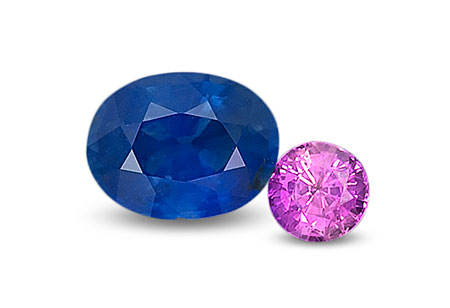 |
| Rwanda sapphires, 1.32 and 0.64 ct; unheated. RWH Collection. (Photo: Wimon Manorotkul) |
As the author of Ruby & Sapphire wanders the byways, the book's eye itself wanders from the gemstones, and we can't complain when treated to these documents of the varieties of human experience, together with compelling images of flora and fauna (as well as terra), all via the viewfinders of Hughes along with his wife Wimon Manorotkul (her opening photos leap from the page: a Glenn Lehrer sapphire carving, a Burmese bearing gifts) and daughter Billie (whose image of Winza miner Obama is a cultural mashup).
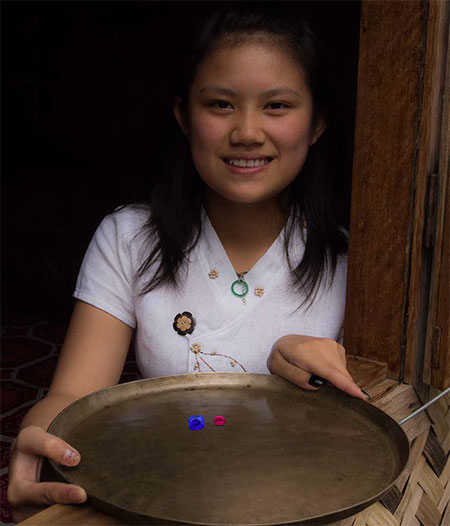 |
| Got the goods. Ma Sandi Maung, above, at Bawpadan in Myanmar's Mogok Stone Tract, 2013. (Photo: Wimon Manorotkul) A miner named Obama, below, sorts ruby outside his hut at Winza, Tanzania, 2013. (Photo: E. Billie Hughes) |
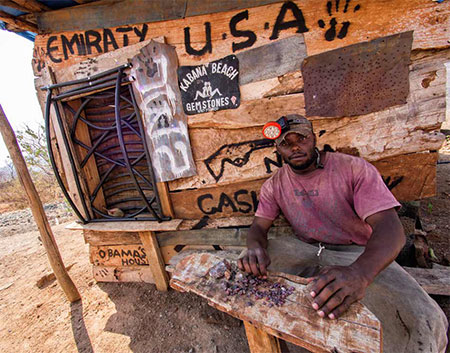 |
And then there are the jewels. My favorites include a Cartier pendant brooch sporting a 28.7-carat diamond-shaped sapphire cabochon from Sri Lanka that, in 1912, reflected the remarkable cross-pollination of Paris, taking its inspiration from Diaghilev's then-new company, Les Ballets Russes. Also from Sri Lanka is a gorgeous ring, sold by Christie's in 2005, featuring a 20.84-carat padparadscha sapphire epitomizing the variety's ethereal lotus-meets-sunset hues. (Hughes, you may recall put this very gemstone up against a strict color-wise definition of padparadscha: it failed.)
Before closing with a visual index of the jewels we've lingered over in its pages, Ruby & Sapphire includes an extensive bibliography, an adjunct to the references that are peppered through each chapter.
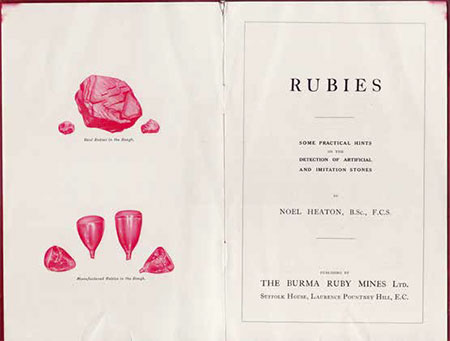 |
| Title page from the Burma Ruby Mines Ltd. response to the advent of Verneuil's synthetic ruby. Sadly, while this was a valiant attempt to protect the natural stone from fraud, it was just the first shot in a battle that continues to the present day. |
Look for Ruby & Sapphire at booth No. 38, ground level, at the AGTA GemFair, February 4–9, 2014, Tucson Convention Center. Also at the GemFair, author Richard Hughes will offer a presentation on the same subject as the book: "Ruby & Sapphire: A Collector's Guide." The presentation will be held Thursday, February 6, 1–2 pm, Mohave Room. The book also is available from Hughes's new venture, Lotus Gemology.
Included in Ruby & Sapphire are two "Collector's Guide" essays, by Bill Larson ("The Connoisseurship of Crystals") and Paula Crevoshay ("The Tao of Jewelry"), which readers will enjoy.
Pala International's Bill Larson discusses the fact that, collectible as they are, few great ruby specimens actually exist, in part because so many of the finest have been cut into faceted gemstones. As a consequence of this rarity, he says, many museums do not own a fine specimen to exhibit, a fact that collectors should keep in mind when doing their legacy planning. Read the entire essay here.
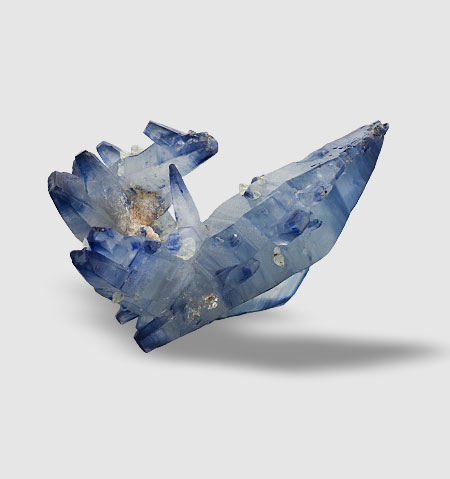 |
| The beauty of nature is revealed through this complex twinned sapphire crystal from Sri Lanka. 88.8 ct. This fine specimen was featured in the Summer 2013 edition of WSJ.Money. (Photo: Wimon Manorotkul) |
Paula Crevoshay is a designer of one-of-a-kind jewelry creations that most recently were exhibited at Pittsburgh's Carnegie Museum of Natural History. Garden of Light: Works by Paula Crevoshay, which was held appropriately during this past spring and summer, featured over 60 of her pieces, taking their inspiration from nature's bounty and beauty. The jewels were juxtaposed with mineral and insect specimens from the Carnegie's collection.
Later this month, visitors to the Orlando Museum of Art will have their own chance to experience a Crevoshay conjunction, on a scaled-down scale. As part of the museum's 90th anniversary celebration, five Crevoshay nature-themed creations will be displayed in a single vitrine, their backdrop being the floral still-life paintings from the seventeenth century's Golden Age of Painting. The display is part of an exhibition that runs January 25 through May 25: Rembrandt, Rubens, Gainsborough and the Golden Age of Painting in Europe from the Speed Art Museum, Louisville, Kentucky.
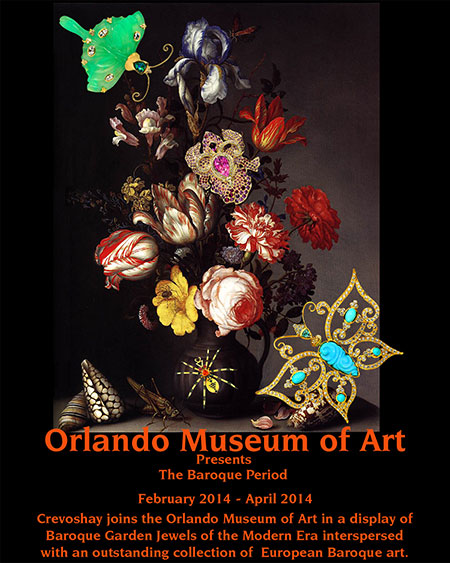 |
| Go for Baroque. As the Orlando Museum of Art celebrates its 90th year with an exhibition of Baroque masterpieces (such as that of Balthasar van der Ast, above), a complementary display will feature latter-day nature-themed Crevoshay jewels on loan from five local collectors. A sixth, a butterfly pendant valued at $19,000, can be acquired by the lucky donor who obtains a $25 chance to win, with the proceeds benefiting the museum's educational programs. The drawing for the pendant will take place in May. |
"The masters of the day," Crevoshay told us, "include, Willem van de Velde, Rembrandt van Rijn, Hendrick van Somer, Jan van den Hecke the Elder, Jacob Van Walscapelle and many more." In conjunction with the exhibition, Crevoshay will present a lecture "on the similarities found in the building blocks of the Baroque Period to what built the 'Nouveau Baroque Period' of our Modern times," she said. And she was kind enough to provide us with a thumbnail sketch of the lecture's details.
During the 1600–1725-plus years there were several major events that radically changed art. First, the religious asylum granted the Protestants from their Catholic countries, which only allowed devotional art; then international trade, which brought in all types of exotic plants, new tools for lapidary, new gemstone materials, and all sorts of commodities; and lastly the major scientific innovations forged during this great time of freedom of expression. This impetus formed a middle class, erected retail establishments, and created retail stores replacing the independent jewelers. Even the discipline of Botany was created during this time due to the many exotic plants coming in through international trade.
In our times we have had similar happenings, creating a surge in excesses in expression in art, science, fashion and consumption starting with civil rights movements that paved the way for the über-wealthy black population to express themselves in all areas previously unavailable to them; the World Wide Web connecting all cultures and topics for a rapid synthesis and growth in all of the arts, sciences and trade; and Hollywood creating a global platform for social fashion expressions, to name a few. The economy and the freedom of expression coupled with innovation has spawned a similar explosion of abundance and excess. Just like King Louis the XIV, men are wearing more jewelry than ever…
Such musing also are reflected in Crevoshay's Ruby & Sapphire essay, "The Tao of Jewelry," in which she explains the principles she looks for in fine jewelry—personal ABCs that can aid the serious collector: Art, Bold, Creativity, Detail, and Excellence. [back to top]
With Pala Presents, we offer selections from the collection of Pala International’s Bill Larson, who will share with us some of the wealth of information in the realm of gems and gemology. And, as with this edition, gemstone-related collectibles.
Garnet, the birthstone for January, is the first in our series of collecting cards that we'll supply over the next twelve months. For more information of birthstones, see Palagems.com.
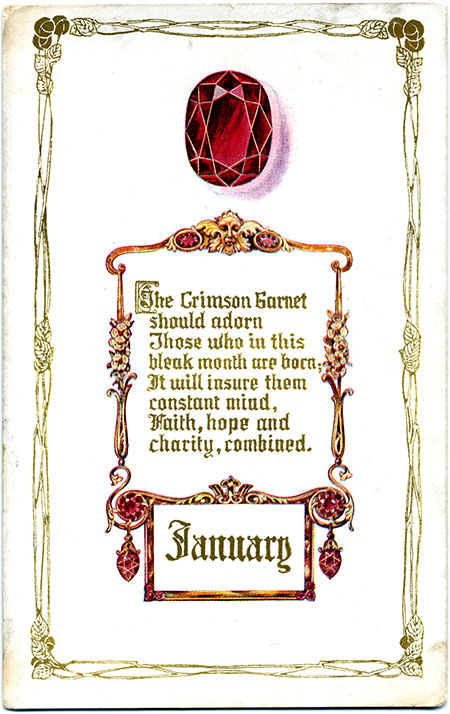 |
| Two other collecting cards for January are available here. |
[back to top]
— End January Newsletter • Published 1/16/14 —
2015.3 | 2015.2 | 2015.1
2014.3 | 2014.2 | 2014.1 | 2013.3 | 2013.2 | 2013.1 | 2012.3 | 2012.2 | 2012.1
2011.3 | 2011.2 | 2011.1 | 2010.3 | 2010.2 | 2010.1 | 2009.3 | 2009.2 | 2009.1
2008.3 | 2008.2 | 2008.1 | 2007.3 | 2007.2 | 2007.1 | 2006.3 | 2006.2 | 2006.1
2005 | 2004 | 2003 | 2002 | 2001 | 2000
Note: Palagems.com selects much of its material in the interest of fostering a stimulating discourse on the topics of gems, gemology, and the gemstone industry. Therefore the opinions expressed here are not necessarily those held by the proprietors of Palagems.com. We welcome your feedback.